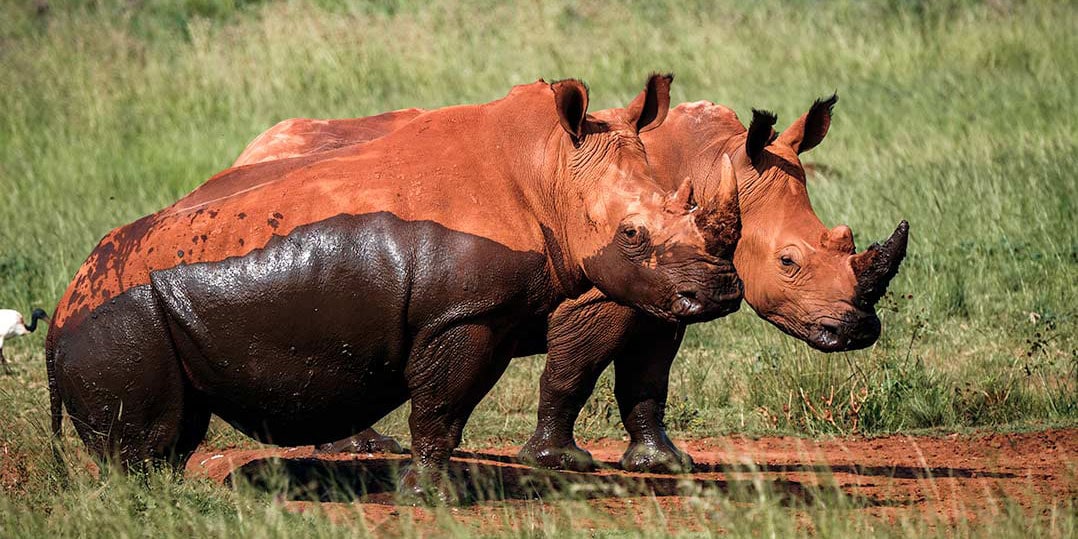Wondering if the Bothongo Rhino & Lion Nature Reserve is worth visiting?
Lars and I have visited the park a couple of times on our South Africa Travels. We’ll share all the practical details, insider tips, and our own experiences to ensure you make the most of your visit.
We’ve also peppered this guide with our Bothongo Rhino & Lion Nature Reserve photos so you’ll have an idea of what you might see.
So buckle up as we journey through the park together to get a real sense of what a day at Lion and Rhino Park might be like.
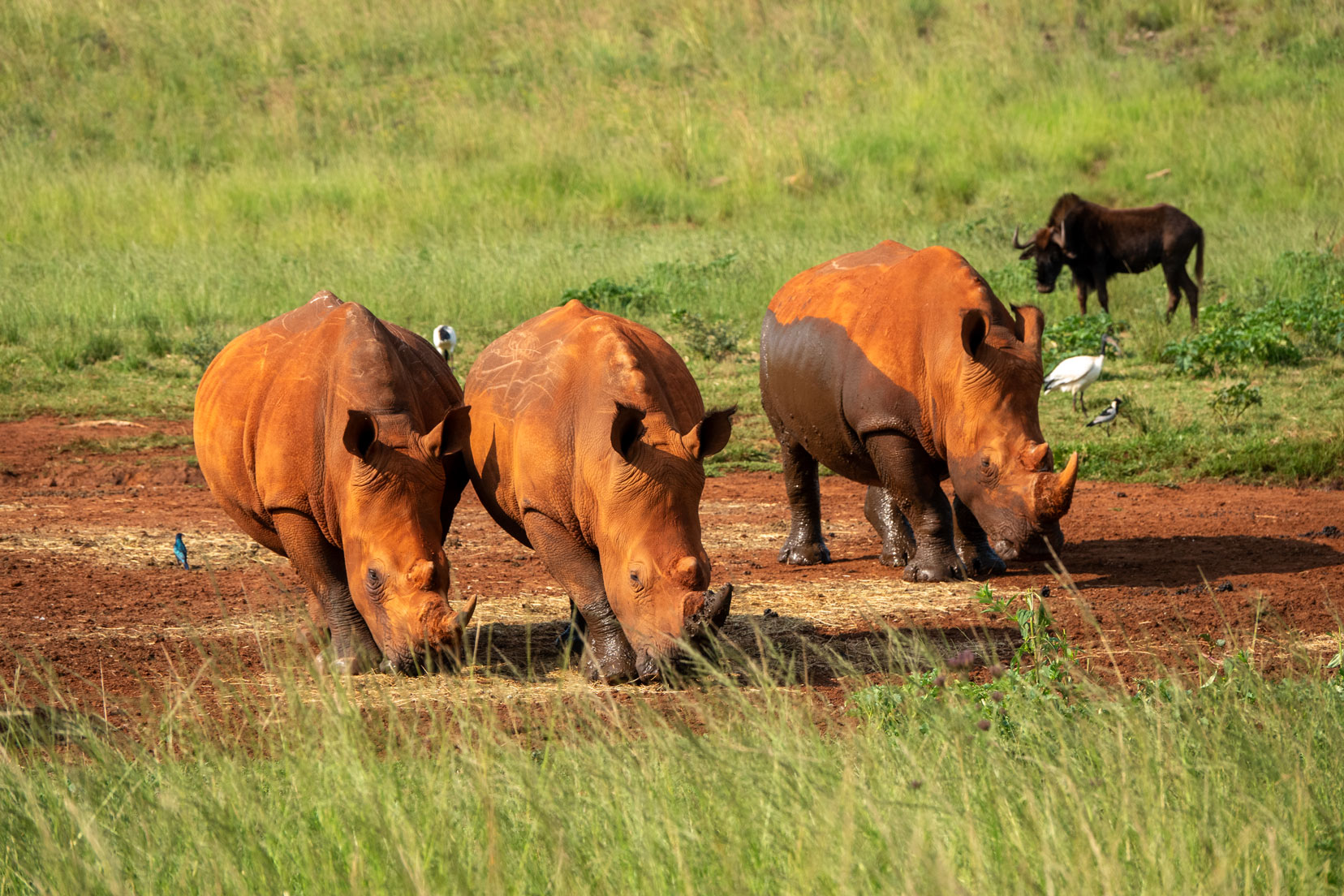
Cradle of Humankind & Rhino and Lion Park Private Tour
You might like to combine a visit to the Cradle of Humankind with a visit to the Lion and Rhino Park run by local Shane Gouldie, a private tour guide in South Africa who receives rave reviews from his guests.
If you love to dig deep into the history and significance of a place, a guided tour can be invaluable. It’s like having a knowledgeable friend along for the ride.
Cradle of Humankind, Caves or Maropeng, Rhino and Lion Park | ⏳ 6-8 hours | ⭐️ 5/5 star reviews | Check Availability
⭐️⭐️⭐️⭐️⭐️ There are no words to express how amazing our experience with Shane was. We saw every animal up close and personal and he seems to have a beautiful connection with the animals. You will not be disappointed with Shane. This is a must-do excursion. Highly recommended. – Renee_A, Jan 2025
⭐️⭐️⭐️⭐️⭐️ Highlight of my Johannesburg stay – Kerry_M, Aug 2024
⭐️⭐️⭐️⭐️⭐️ Fantastic day with a wonderful guide!: Farah_S, May 2024
First Impressions at Bothongo Park
We were cruising down a dirt road when suddenly, a massive buffalo headed towards our safari vehicle. It was a heart-stopping moment, but our guide, Mike, assured us there was no danger. It was just ‘Old Stompy’.
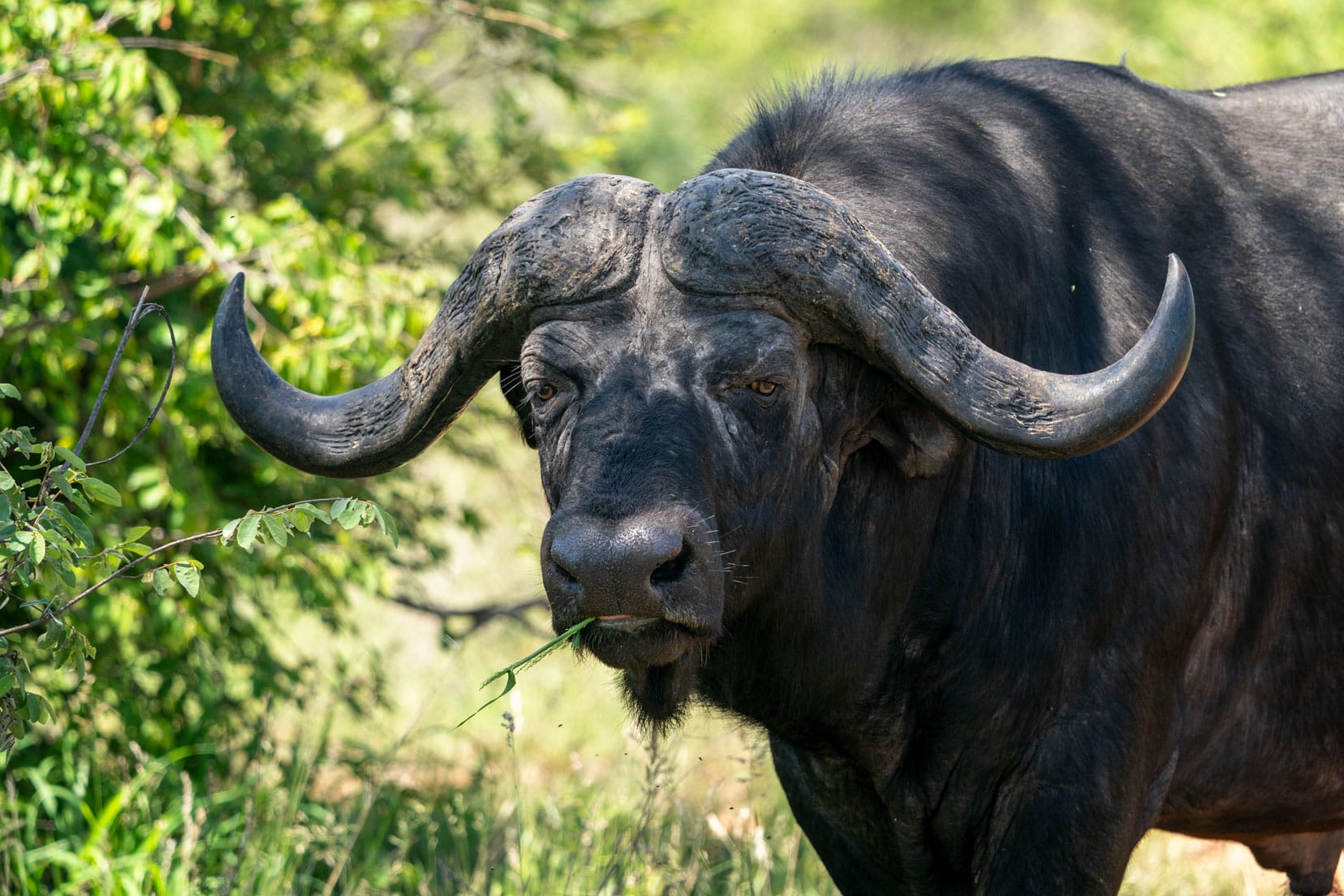
This isn’t a photo of Stompy – at the time, I was too fixated on worrying whether I was safe to take a shot – but this is a buffalo.
Also, at the time, I’d recently read that if a buffalo has its sights on you – run up the nearest tree!
It seems funny now because we have seen so many buffalos on South African safaris since, especially on our four months in Klaserie Private Nature Reserve and our self-drive through Kruger, but that was my first buffalo sighting up close.
Now I only get worried if I see them when on foot!
And that was our introduction to Bothongo Reserve.
💡Lifejourney4two Tip: If you find yourself face-to-face with a buffalo, remember to stay calm and trust your guide.
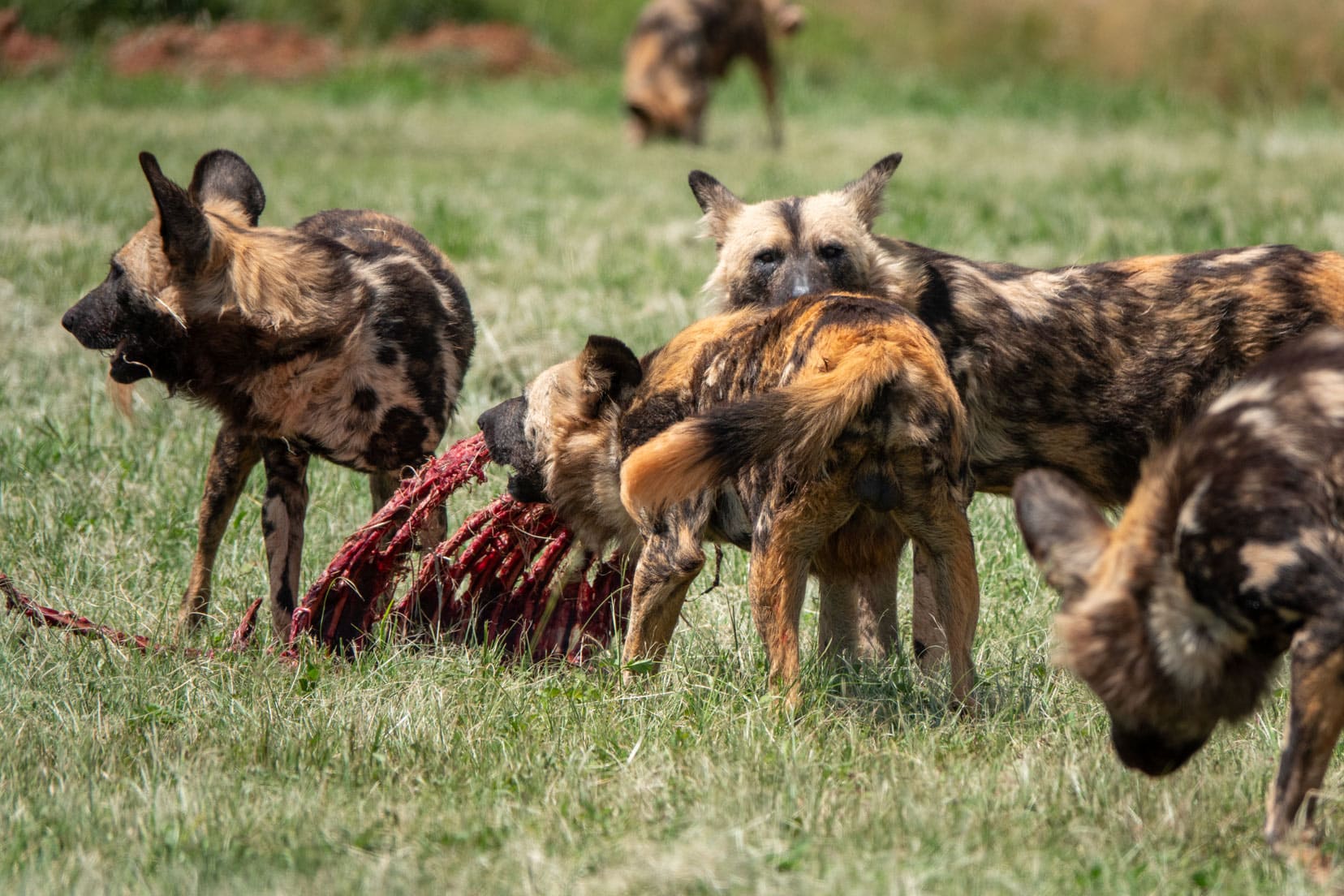
About the Rhino and Lion Nature Reserve
So what makes this lion and rhino park in Johannesburg so special, and what awaits you on a visit?
- It is only 45 minutes from Johannesburg
- You can experience a mini safari near the city
- It’s situated within the Cradle of Humankind – combine a visit to both
- There are plenty of activities for a full-day trip with the kids
- Restaurants and accommodation top off the experience

A Suburban Safari
One of the best things about the Bothongo Rhino & Lion Nature Reserve is its location. It’s just a stone’s throw away from Johannesburg, making it an ideal day trip for those who want to experience the wild without venturing too far from the city.
So, if you’re short on time but big on adventure, this park offers the perfect suburban safari experience. Lars and I found it to be a convenient escape from the urban hustle.
Being only about an hour’s drive from Johannesburg gives the park its catchphrase of being the Nearest Faraway Place.
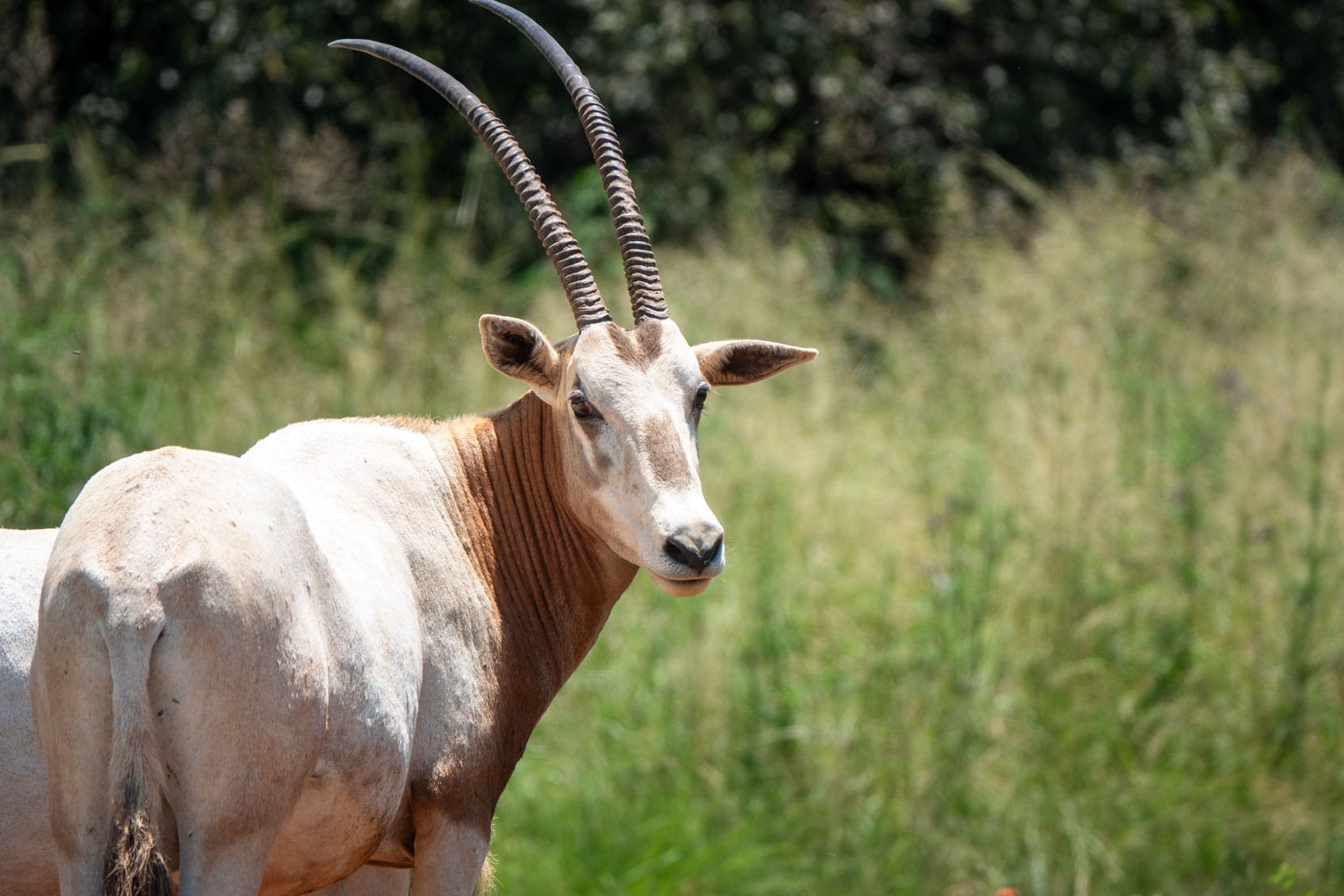
So, rather than travelling 500 kilometres east to see the iconic African wildlife in Kruger National Park, a visit to the Rhino and Lion Nature Reserve in Krugersdorp gives you the opportunity to see some of these animals up close in this environment instead.
However, this is nowhere near as exciting as a real safari and seeing animals in their natural environment, but if you are close to Johannesburg and looking for a fun day out – the Lion and Rhino Nature Reserve fits the bill.
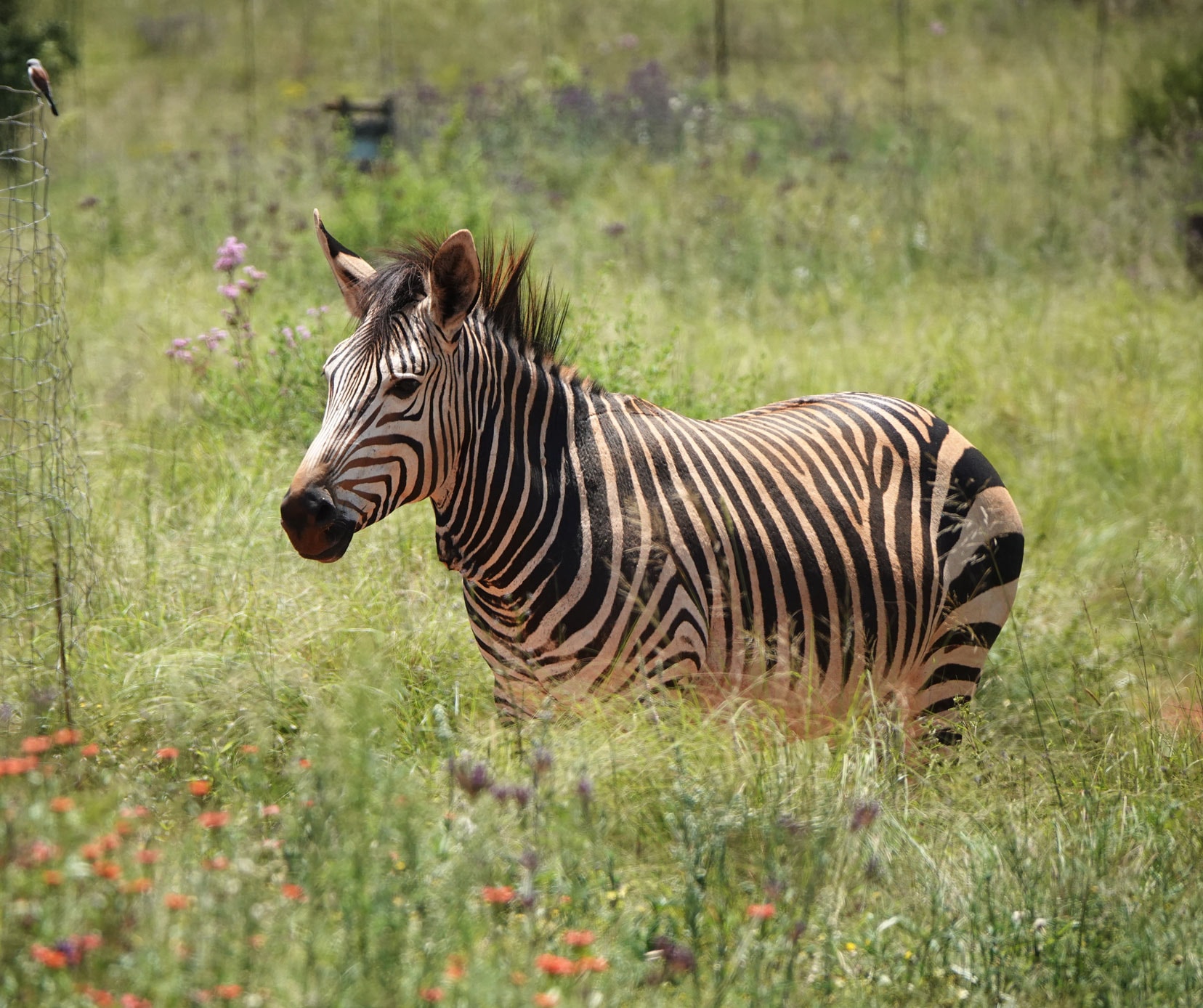
With over 1600 hectares to explore and more than 650 animals, you’ll feel miles away from anywhere and have a safari experience just a stone’s throw from Johannesburg.
Whether you have just landed in South Africa and are looking for your first animal encounters nearby or live locally and want a super fun day out, this has to be one of the best places to go.
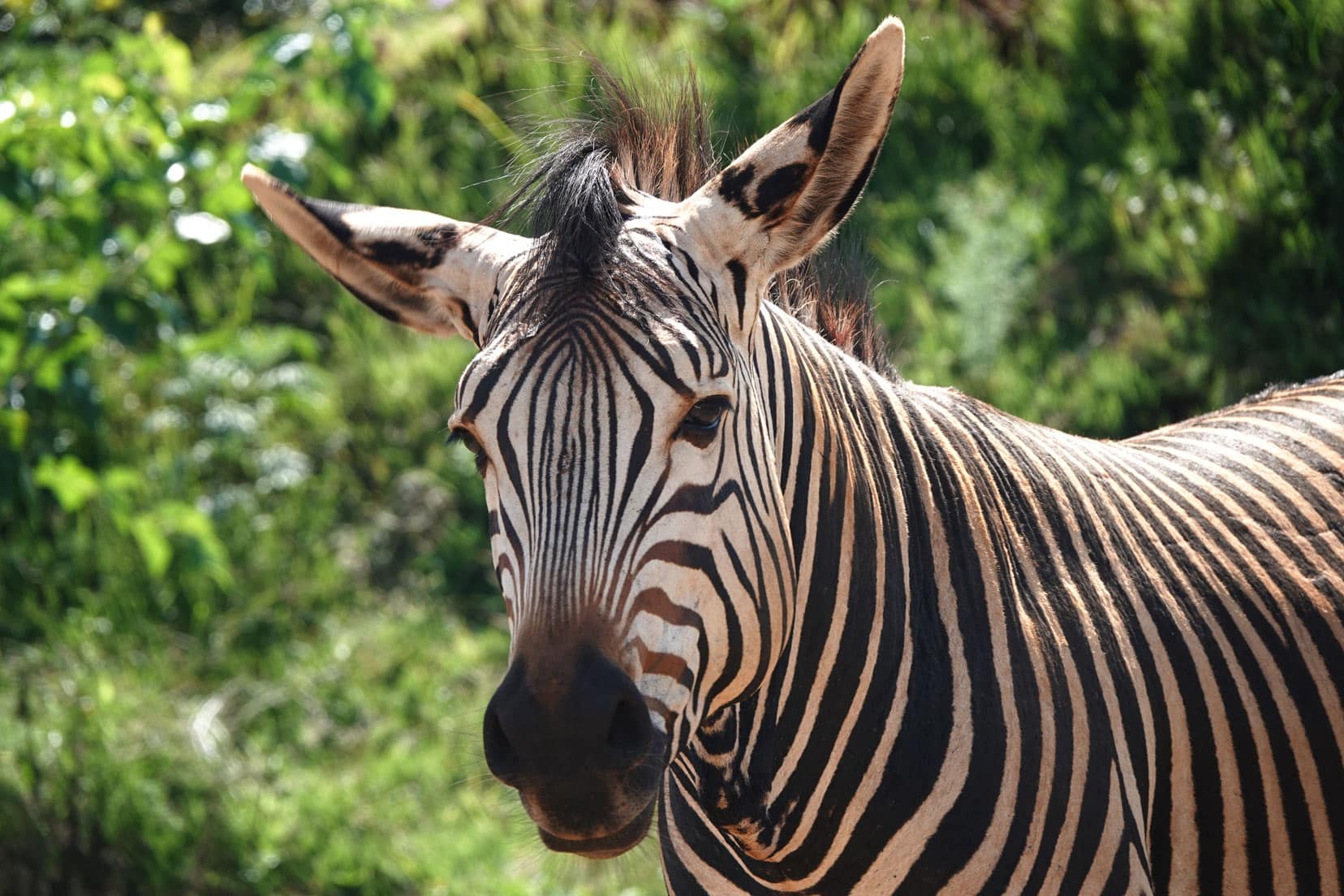
Within the Cradle of Humankind
The Bothongo Rhino & Lion Nature Reserve is part of the Cradle of Humankind, a UNESCO World Heritage Site.
This adds another layer of fascination to your visit.
The area is renowned for its many human ancestor fossils, and you’ll see the Magaliesberg Mountains, formed over 2 billion years ago.
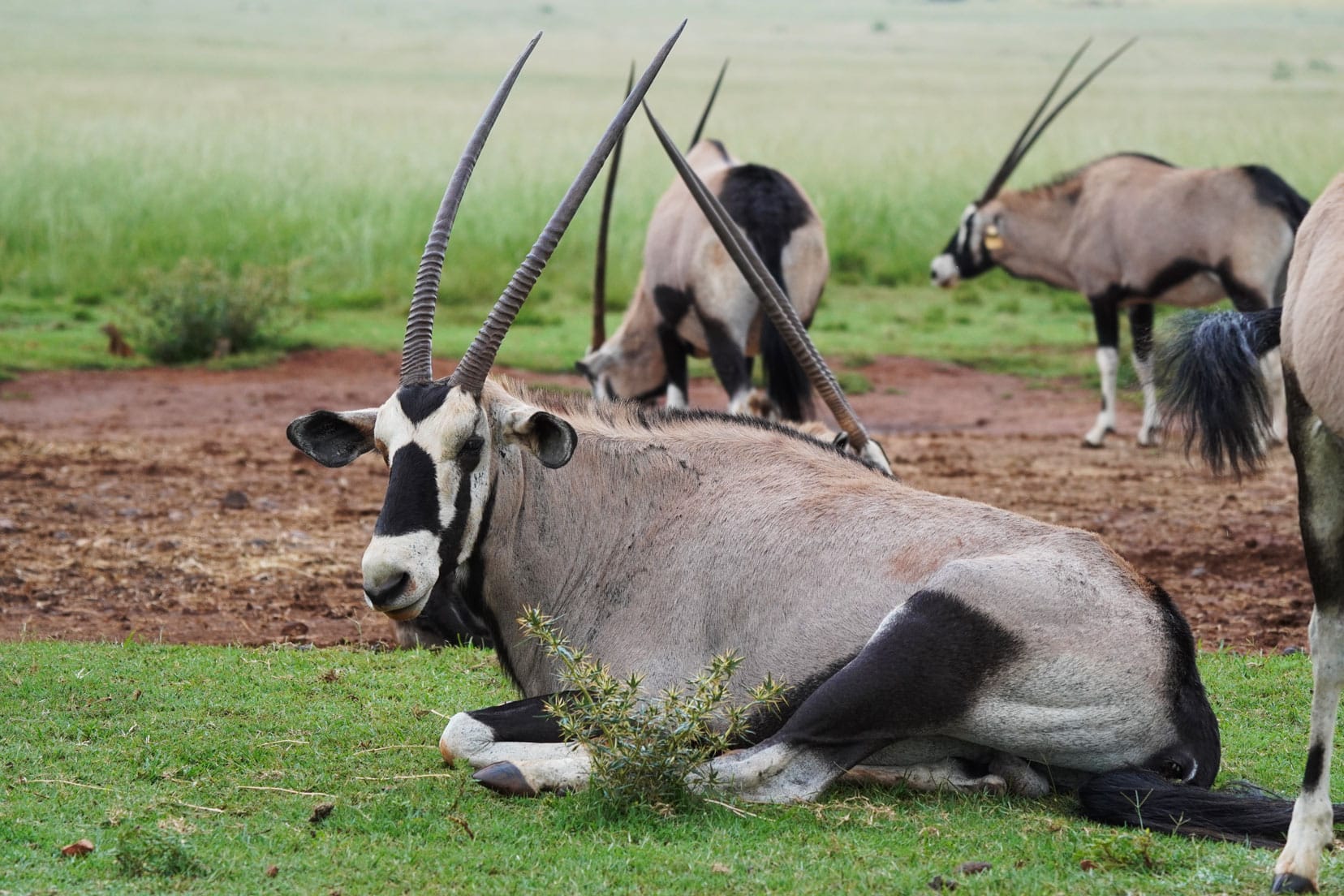
What’s on Offer at the Rhino and Lion Park?
- Wildlife Education Centre
- Hippo River Walkway
- Bothongo Wonder Cave
- Dining options and accommodation
- Bike Park and Reptile House
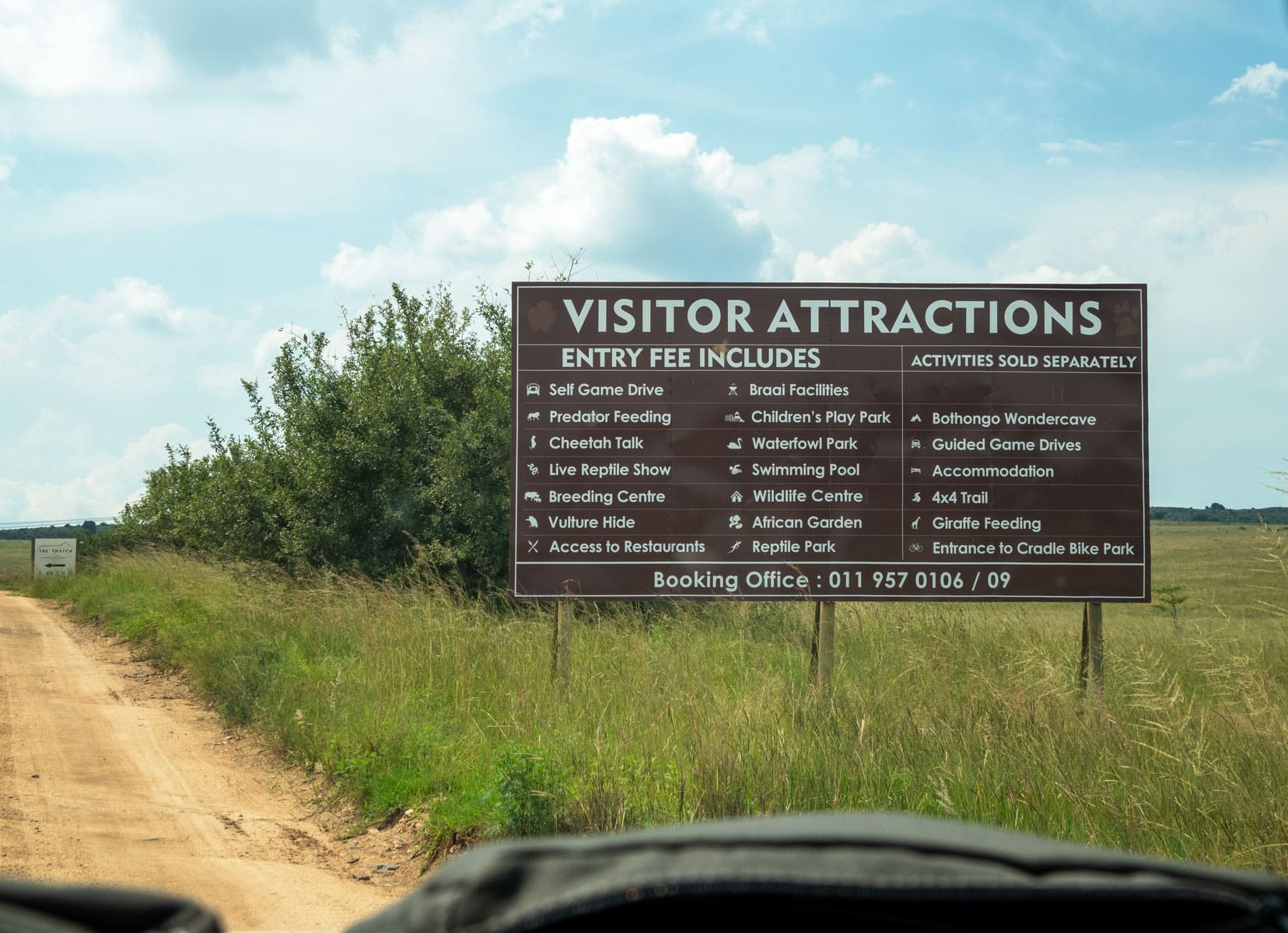
Rhino and Lion Park Self-Drive
It’s easy to self-drive around the Rhino and Lion Park, and a two-wheel drive is fine. If you have a four-wheel-drive vehicle, there are clearly marked extra tracks that you can take.
As you enter the park and pay your entrance fee, you receive a free Field Guide with a map so you can plan your route and use the guide to identify the animals.
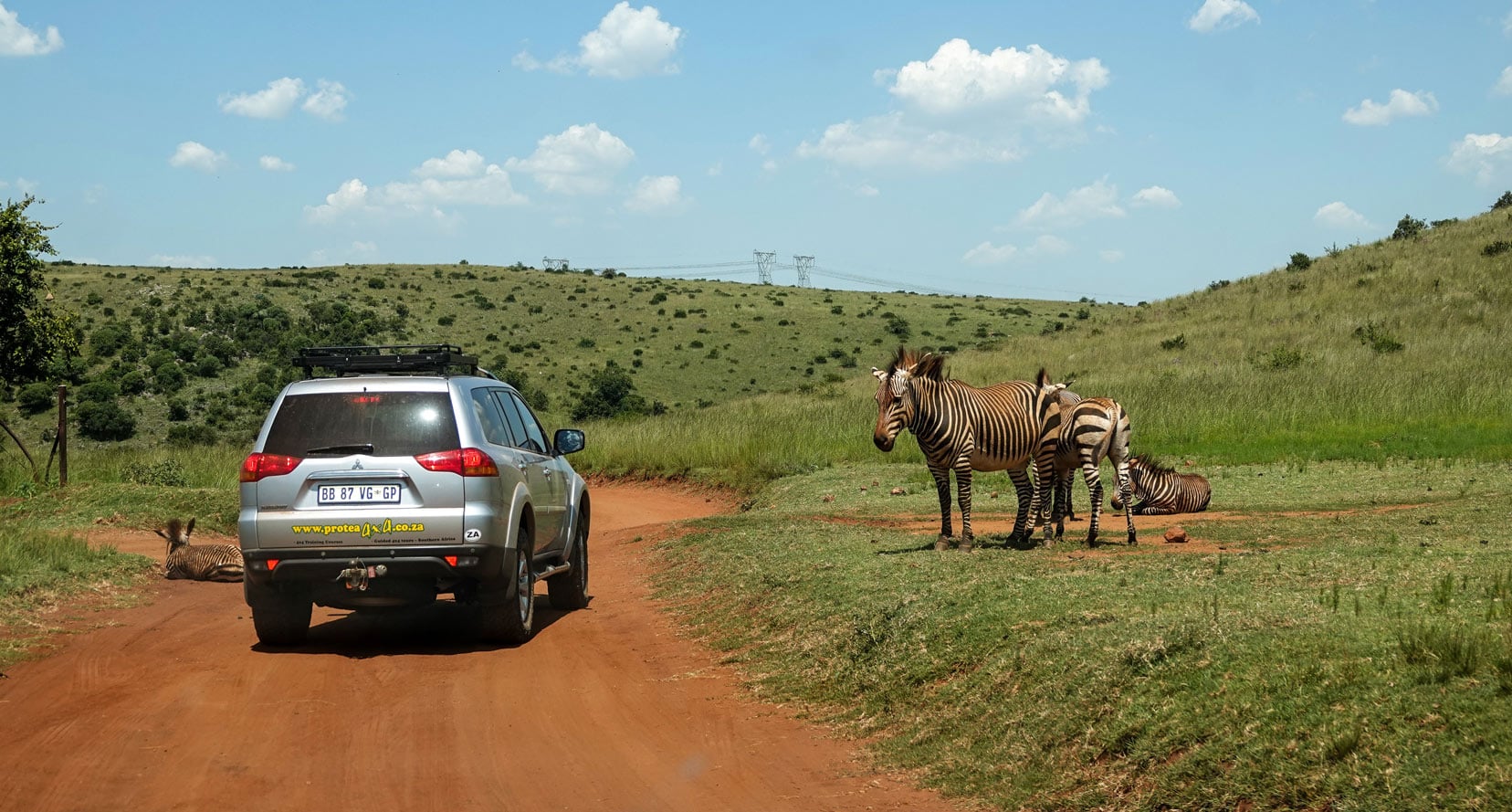
Self-Drive Rules
- Stay in your car in designated zones
- Keep windows closed in the ‘Predator Camp’
- Respect the speed limit and the wildlife
If you don’t have your own car or want a guided tour, then you might like this full-day tour to the Bothongo Rhino and Lion Nature Reserve from Johannesburg. The price includes entrance to the park and Bothongo Cave and a guide.
Rhino & Lion Safari and Wonder Cave Tour | ⏳ 8 hours |⭐️ 5/5 star reviews | Book here
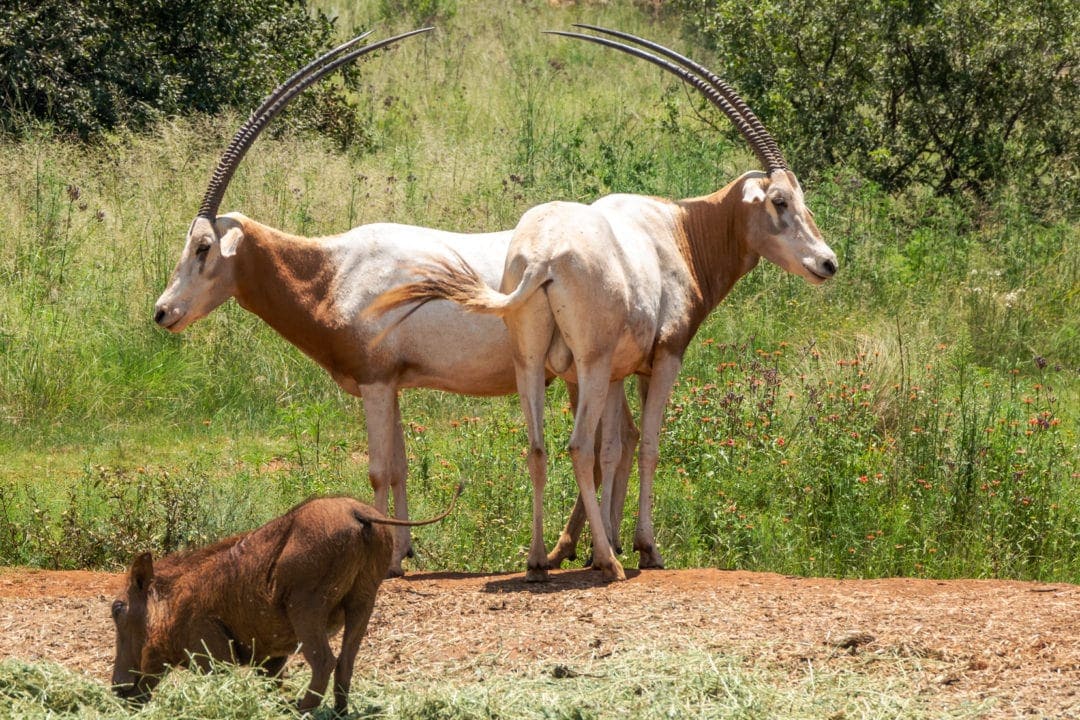
Rhinos and Lions at the Reserve
With a name like the Rhino and Lion Nature Reserve, you would expect to find lions and rhinos. You’d, of course, be right.
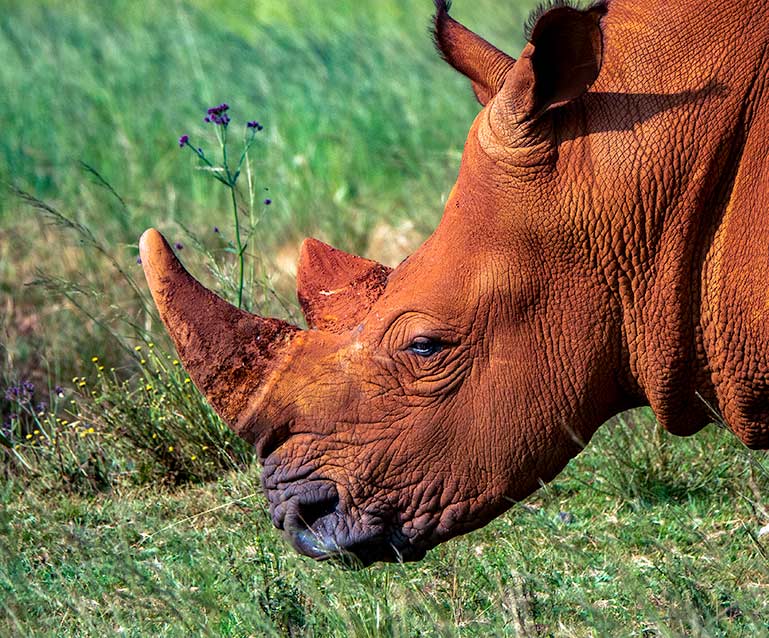
Rhinos in the Park
But the rhinos are free to roam the park’s vast area; therefore, a sighting isn’t necessarily guaranteed. This only adds to the thrill of being on the lookout for these incredible wild animals.
You won’t be able to find exactly how many rhinos are at the Rhino and Lion Park, as sadly, rhino poaching is a real threat there.
The park has 24/7 on-the-ground anti-poaching security to protect these endangered animals.
We hadn’t spotted one rhino at the end of our guided tour and our self-drive through the park. We were reluctantly heading towards the exit, as it was near gate closing time when we were lucky to find a whole crash of rhinos (‘Crash’ is the collective term for a group of rhinos).
There were about seven playing around the waterhole on the left of the park as we headed out.
Rhino and Lion Park Video
Here’s a short (one-minute) video showing the rhinos, a couple of warthogs, and the hippos seen from Hippo Walkway.
Lions in the Park
The lions are situated in the ‘Predator Camp’, so your chances of seeing them increase — especially if you arrive around feeding time.
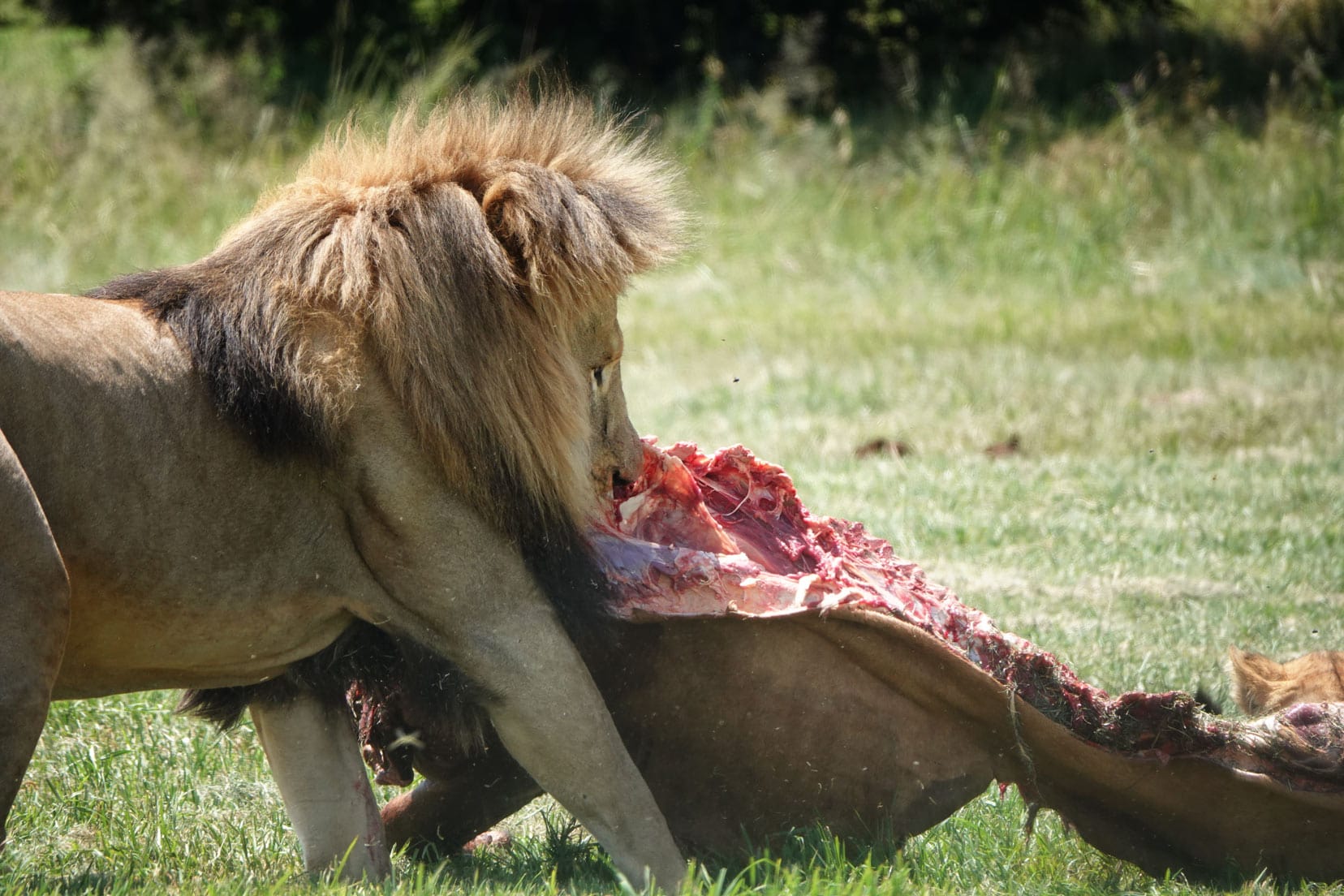
The lions are fed midweek and at weekends. Because they are in their own part of the reserve, they aren’t able to hunt, so they are fed.
Feeding times are a drawcard because you are almost guaranteed to see the pride tearing apart their home-delivered dinners. And you might notice the telltale signs of an enjoyable meal smeared across their chins.
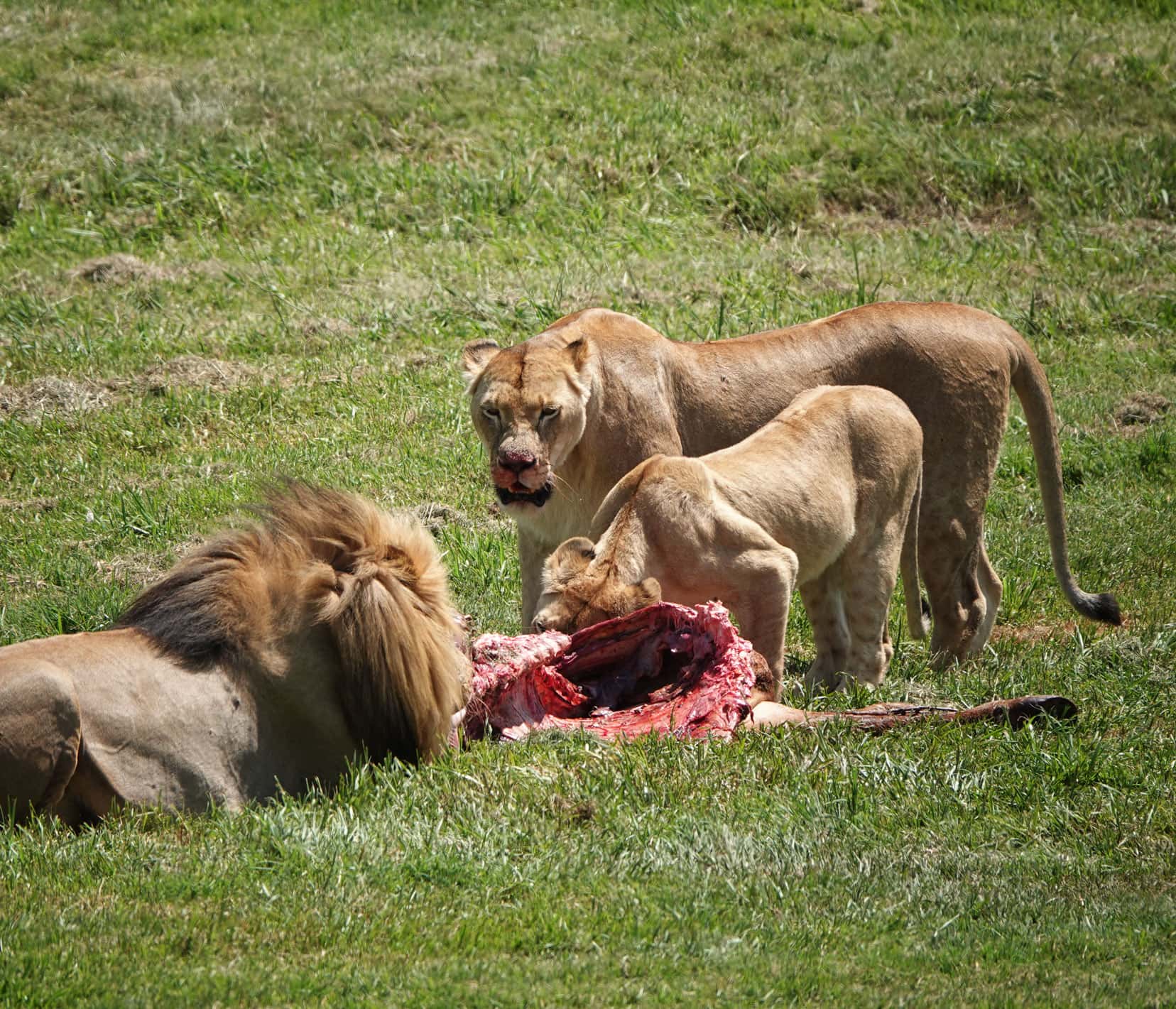
The Predator’s Camp
As mentioned, you’ll find the lions in the Park’s Predator Camp— a separate area of a hundred hectares in the park.
In the lion and predator camp, you’ll find a pride of tawny lions, white lions, wild dogs and cheetahs.
On our visit, we saw the tawny lions feeding, but we didn’t see the cheetahs or white lions. We ran out of time as there was just so much to see.
💡Lifejourney4two Tip: We’d recommend getting to the nature reserve early to make the most of your day’s entrance ticket.
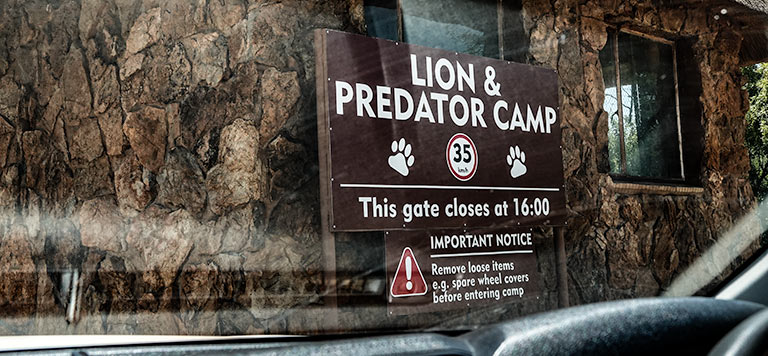
Other Wildlife in the Reserve
You won’t only find rhinos and lions at this Krugersdorp Nature Reserve.
You’ll find an array of Hartman’s zebra, eland, oryx, wildebeest, impala, warthogs, ostrich, vultures, black-backed jackals, and so much more wandering freely across the nature reserve.
We were told that the Rhino and Lion Nature Reserve management team are dedicated to creating a place where the public can learn about the animals, the environmental issues and the concepts facing our wildlife today.
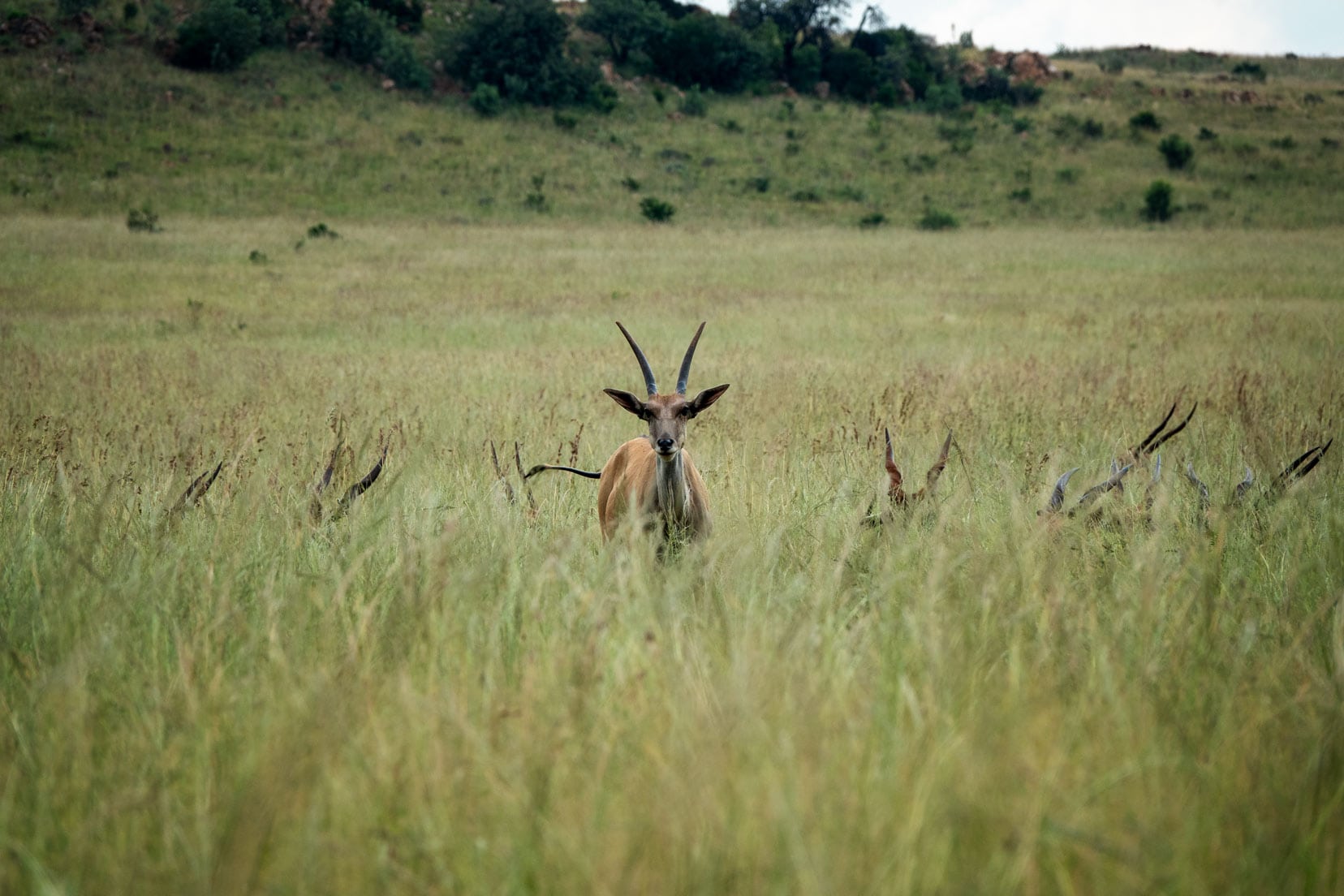
The Hartmann’s Mountain Zebras are a vulnerable species. The difference between these and the more common Plains Zebra is that the Hartmanns don’t have stripes on their underbelly, and their stripes are narrower.
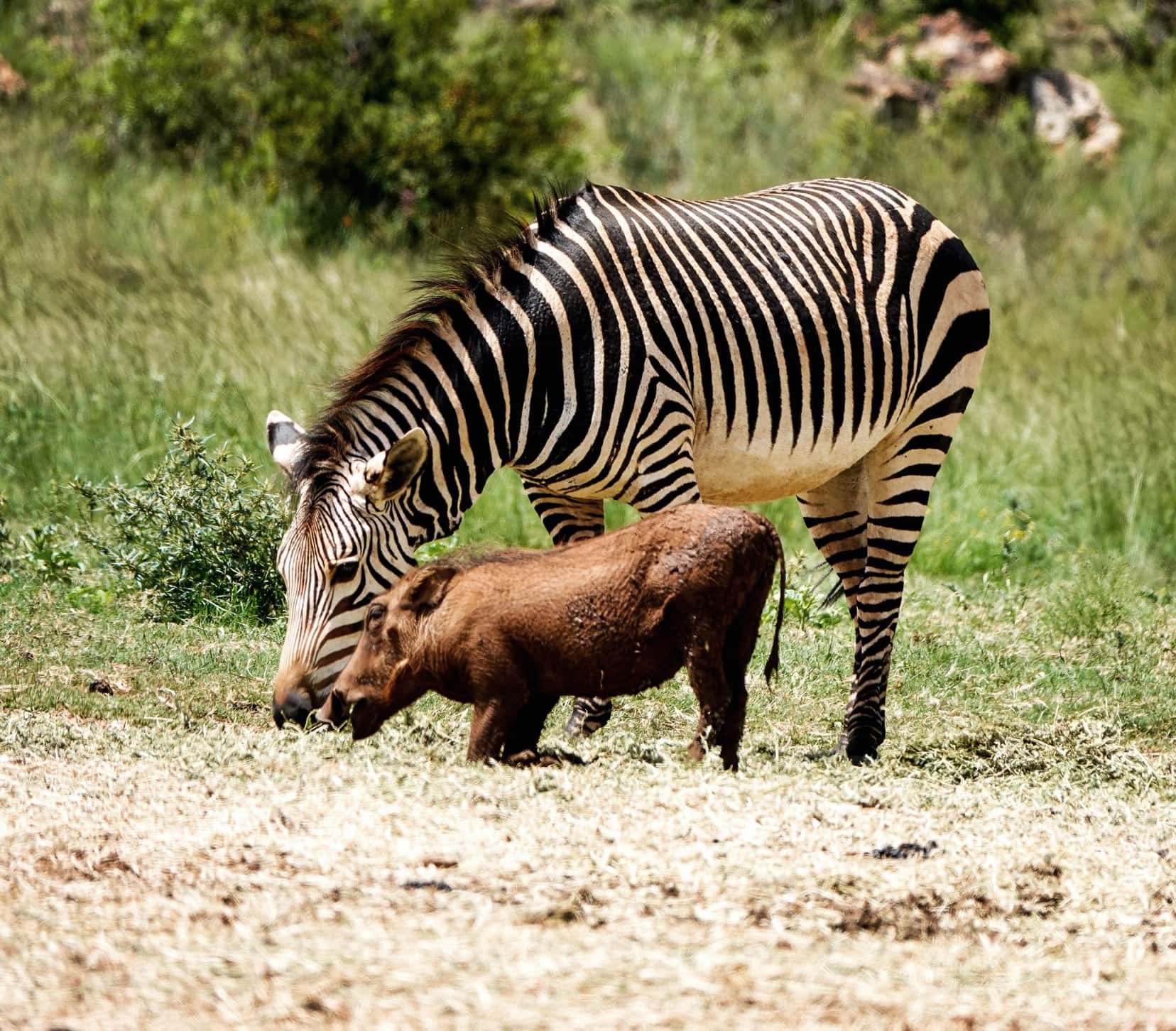
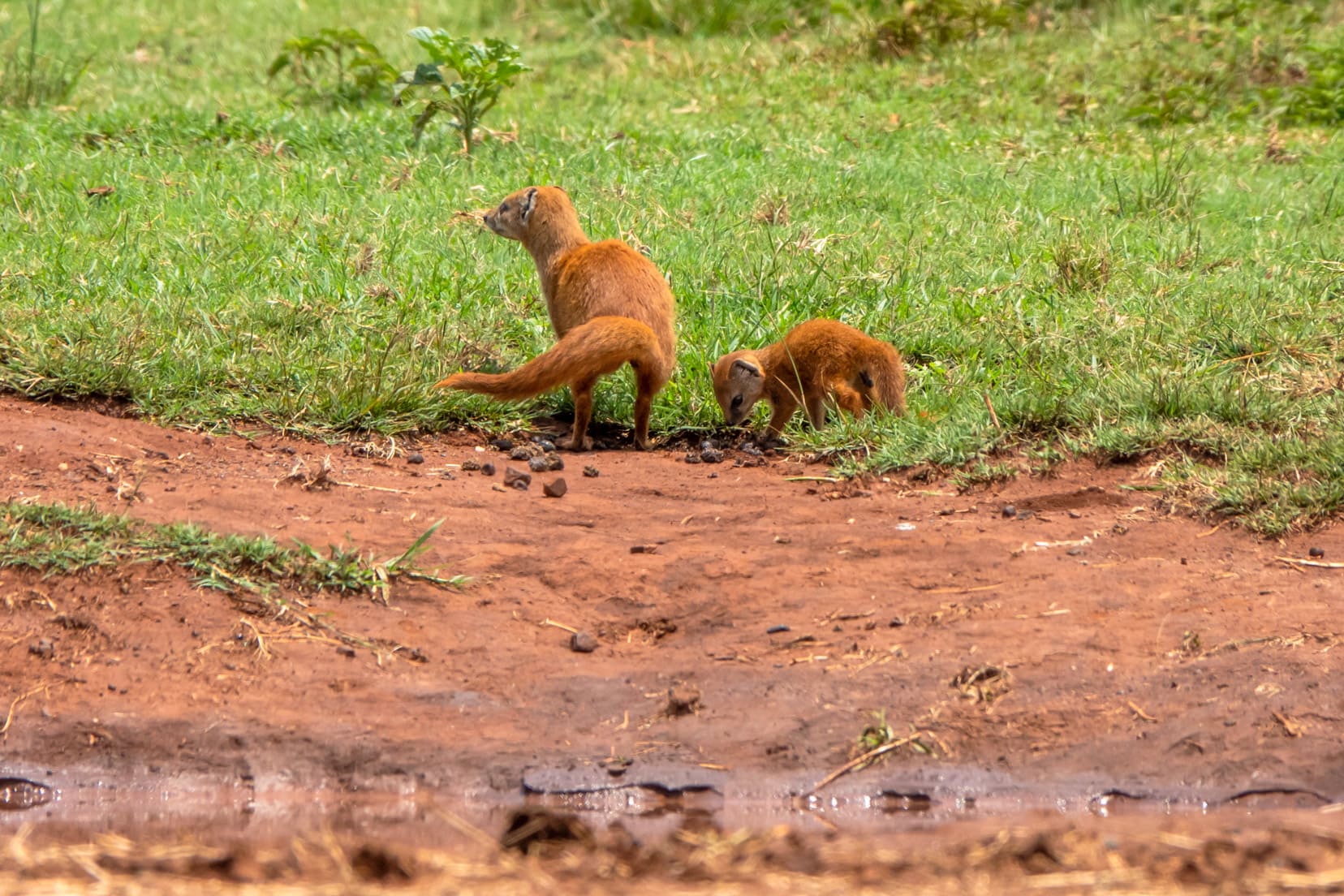
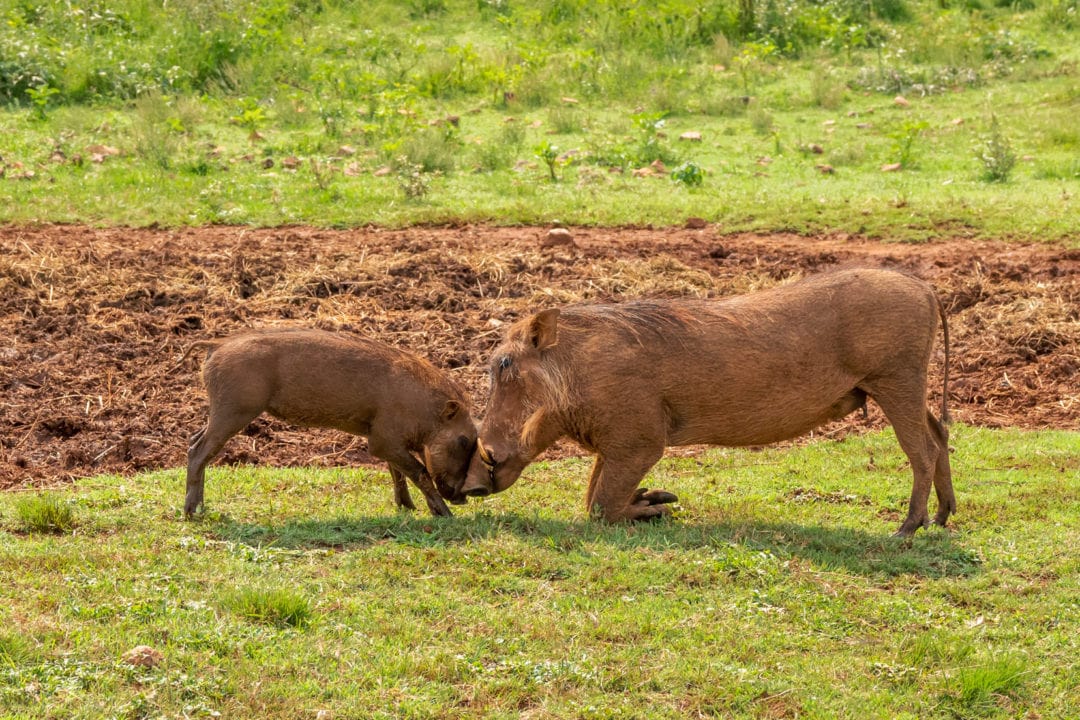
Rhino and Lion Wildlife Centre
There is an educational Wildlife Centre at the Rhino and Lion Reserve and the vast acres of the Nature Reserve to drive in.
Some of the wildlife enclosures were undergoing renovation and extensions when we visited. The idea was that the reserve was investing in developing individual enclosures to mimic the animal’s natural environment.
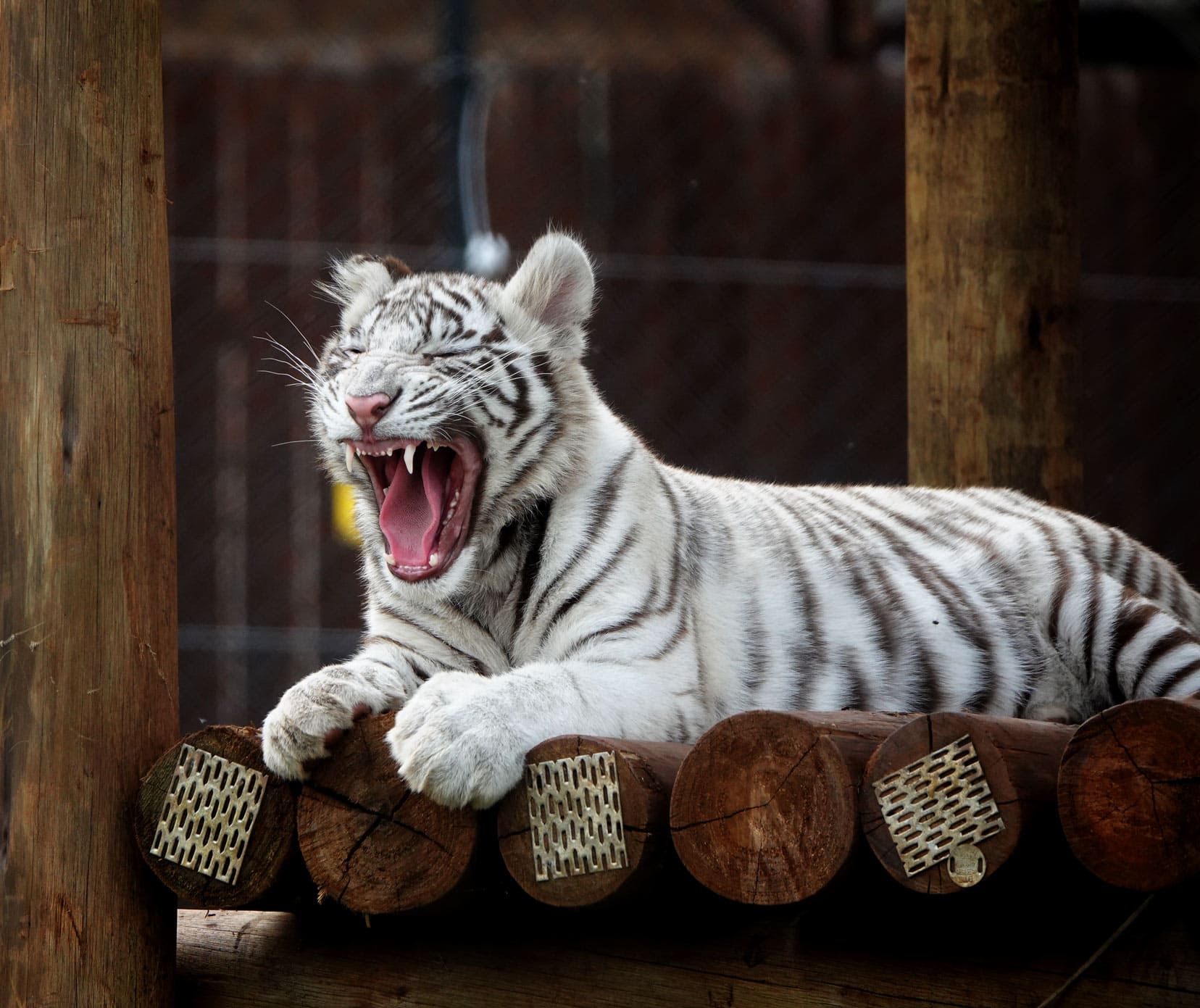
All of the animals at the wildlife centre have been born in captivity as part of conservation efforts to ensure their sustainability.
The primary function of the Wildlife Centre is to increase awareness of our threatened species and educate about how to conserve and sustain our precious wildlife.
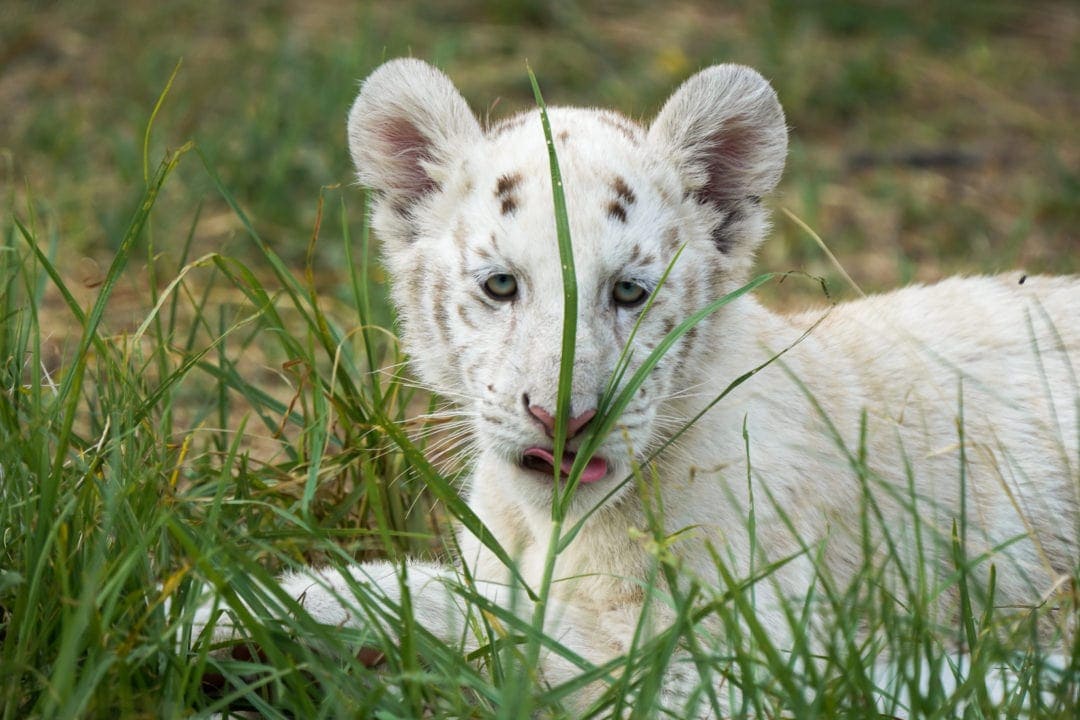
These white tiger cubs were bouncing around, having a whole heap of fun before collapsing in a heap for a much-needed rest.
Unfortunately, they had to be hand-reared as their mum rejected them at birth.
What is really important, though, is that the public is not allowed to pet them. Until recently, many facilities in South Africa, and some still do, allowed the petting of baby wild cats.
The Rhino and Lion Nature Reserve Johannesburg decided, in line with their new values and ethos, that this practice had to cease.
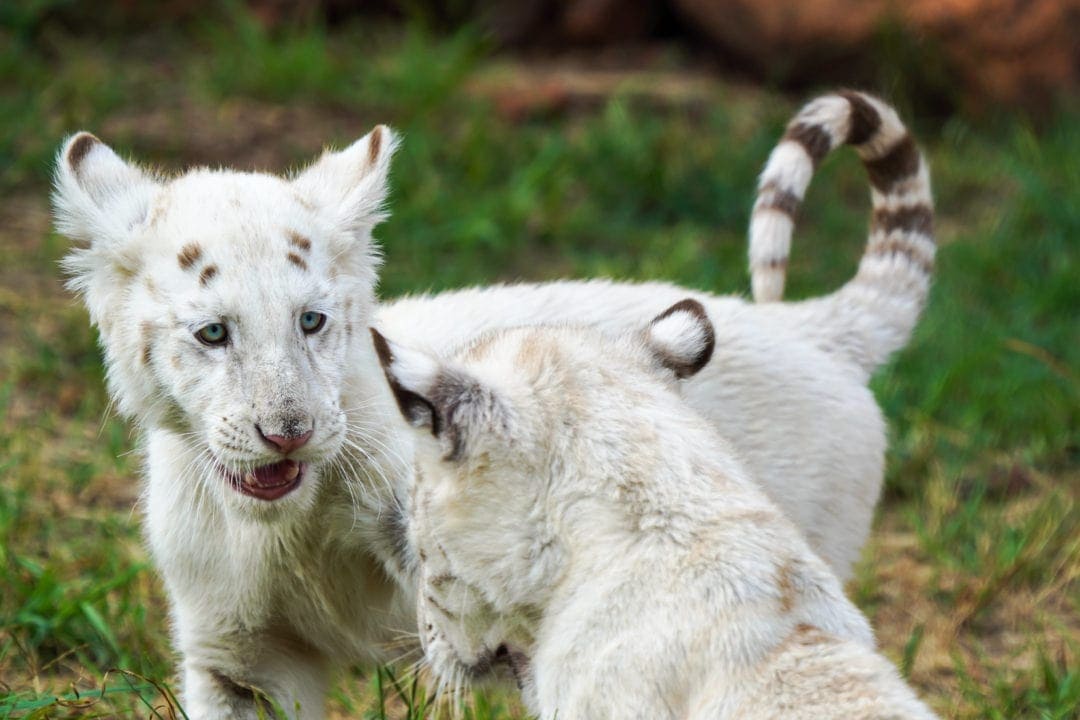
Why is No Petting Allowed?
It might be tempting to pet a baby wild cat, but here’s why it’s a no-go:
- It disrupts their natural behaviour
- It’s detrimental to their health
- It poses a risk for future poaching
This becomes especially poignant when you learn:
- These little cuties need to sleep about 80% of the day. Having people petting them all day would seriously affect their health and development.
- Wild animals used for petting are taken away from their mothers and bottle-fed, meaning that they are not getting the correct nutrients or bonding.
- When the cubs are older and no longer cute, they are often sold to canned hunting farms or sold for meat.
- The animals become familiar with humans, which can work to poachers’ advantage.
For more on ethical wildlife tourism, read our post on volunteering with animals in South Africa.
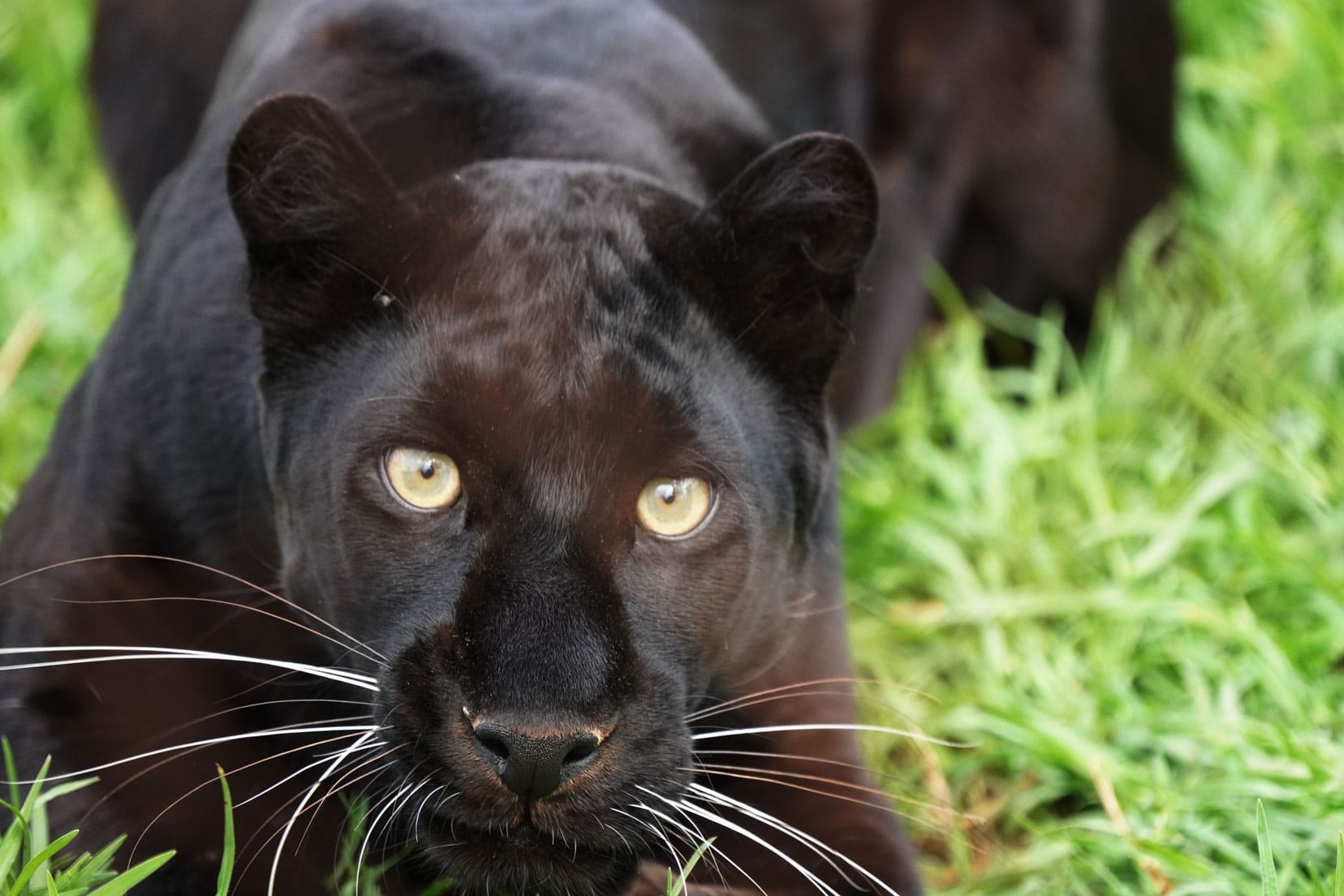
The Wildlife Centre houses leopards, a black panther, a black leopard, a clouded leopard, white tigers, a pygmy hippo and many more animals to learn about.
Close by is also the Reptile House. Unfortunately, we missed visiting it while we were there, but it has various snakes and other reptiles.
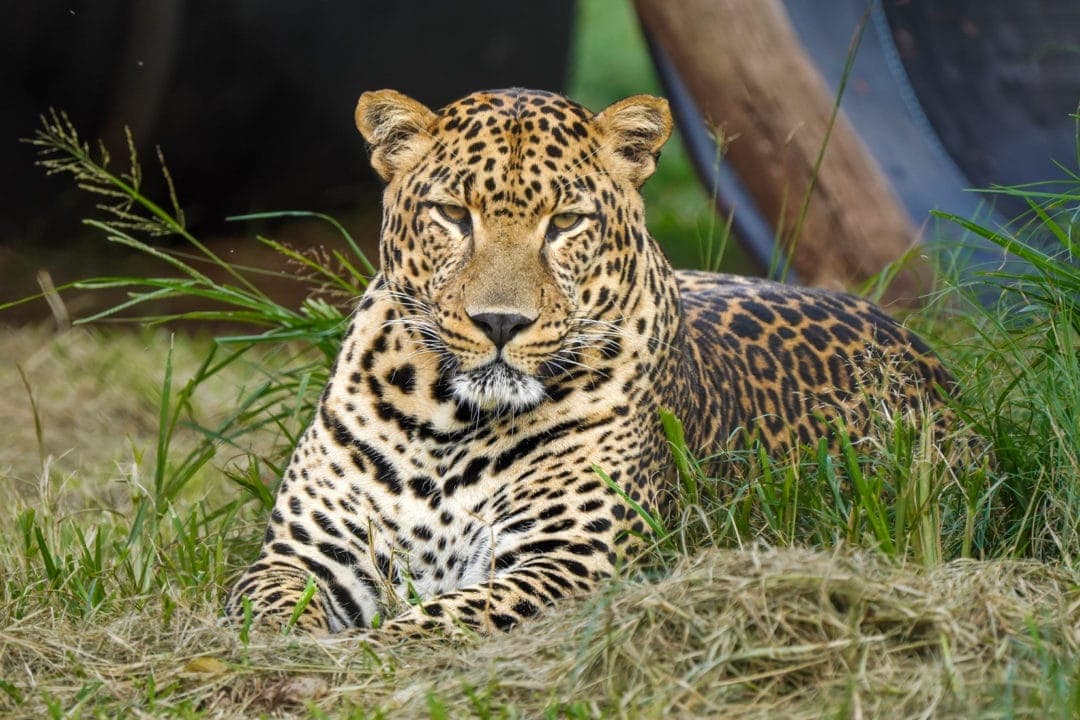
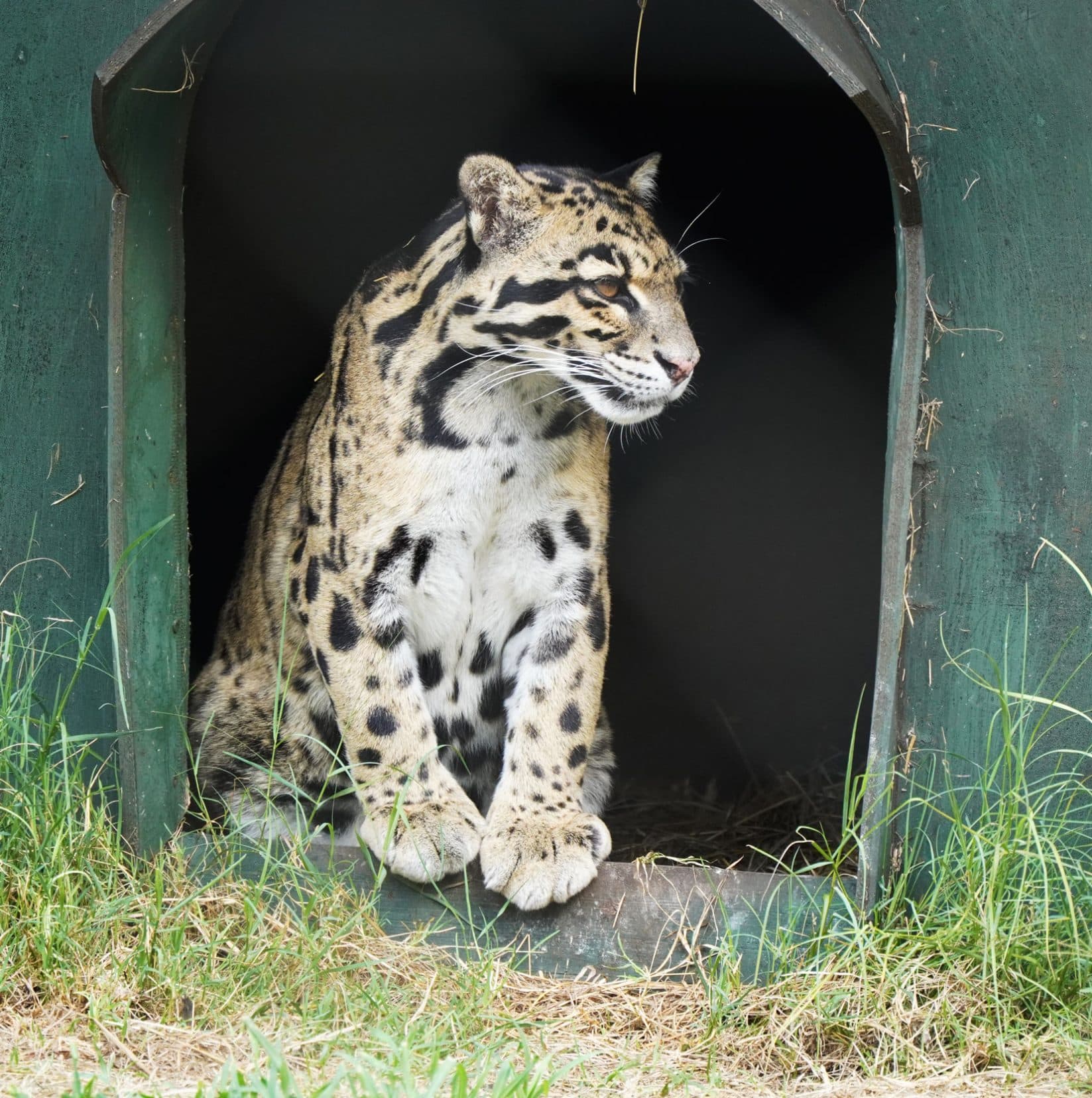
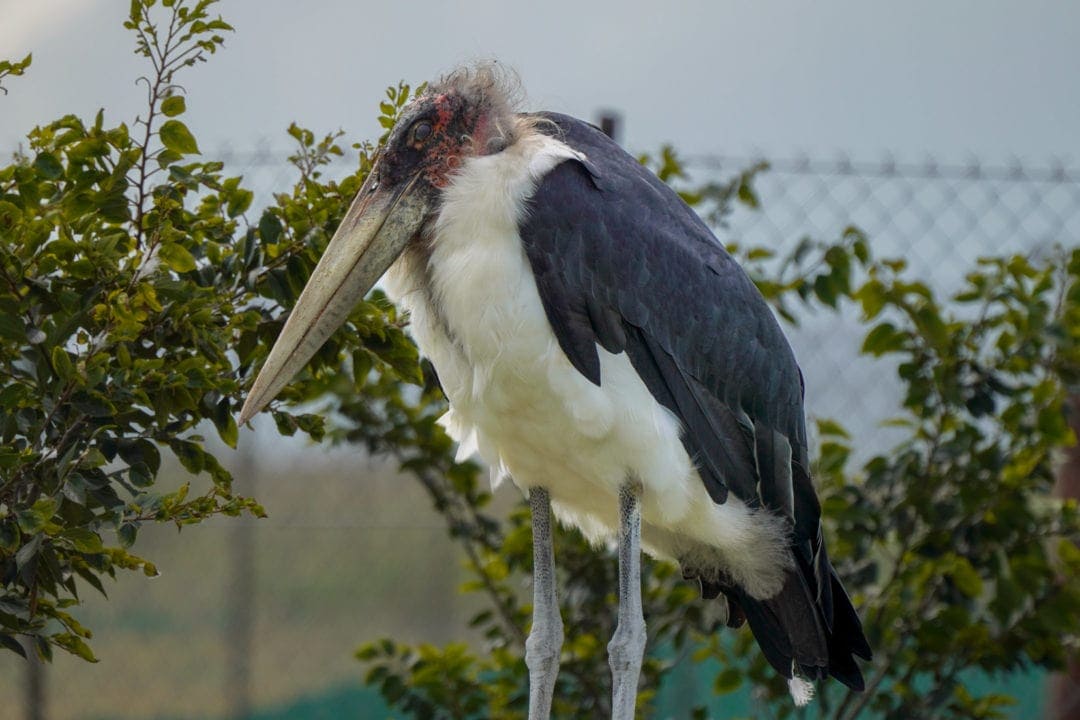
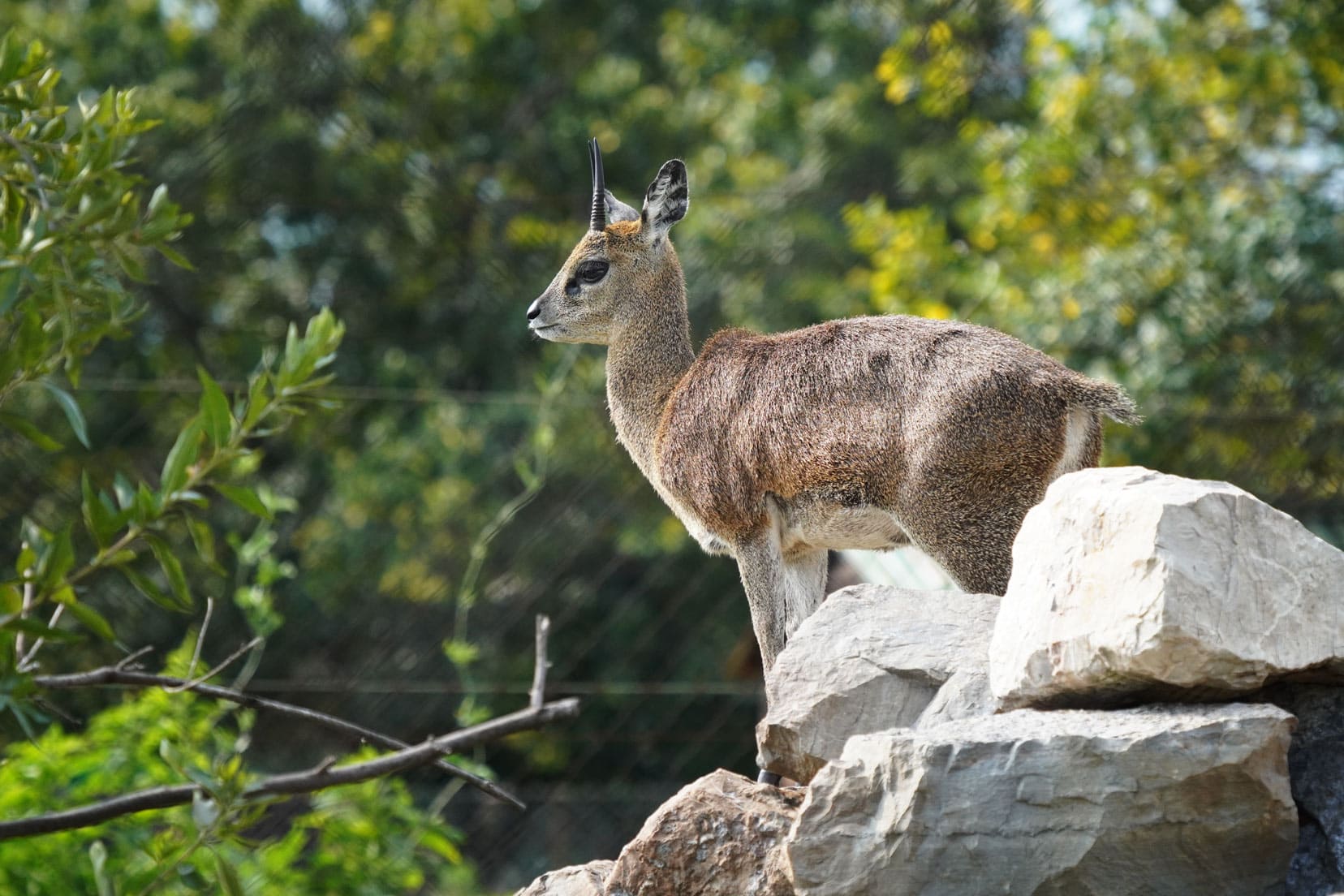
The Hippo Walkway
When you arrive at the Rhino and Lion Park, you’ll first arrive at the free car park beside the Neck and Deck Restaurant.
Across the road is the Hippo Walkway.
We were lucky enough to see a family of hippos frolicking in the river. Watching these huge hippos bobbing their heads up and down was amazing, and we captured some great shots.

In amongst the reeds, by the Hippo Walkway, we saw our first Red Bishops. This common South African bird was an interesting sight for us, coming from Australia, with its characteristic red helmet.
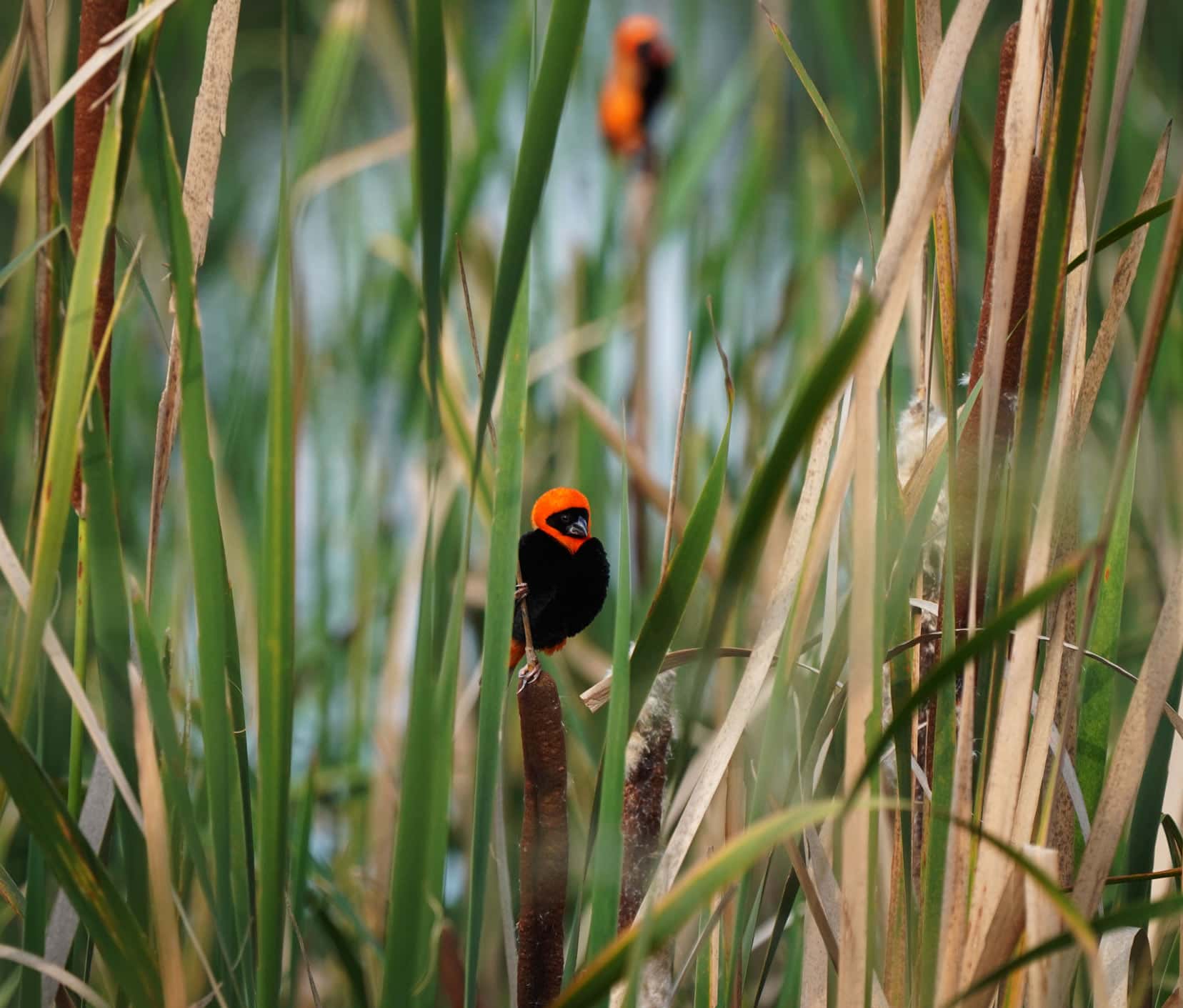
The Bothongo Wonder Cave
Within the grounds of the Bothongo Rhino and Lion Nature Reserve is another popular attraction — the Bothongo Wonder Cave.
It was discovered in 1898 when miners came across it while mining for limestone. It is a huge cavern, with stalagmites and stalactites creating all sorts of shapes.
Entrance to the caves costs an additional amount, and you pay as you enter the Reserve.
We drove all the way to the caves but realised that the tours were every hour, and we hadn’t yet visited everything else.
Again, running out of time, we skipped the tour, but we did stop and listen to the guide tell us a bit about the caves and took a photo of the first 87 steps you climb down before taking a lift that takes you down to the cave 60 metres below ground.
💡Lifejourney4two Tip: Find out the time of the Wondercave tours while you are at the Rhino and Lion Nature Reserve entrance so you can plan your day accordingly without wasting any time.
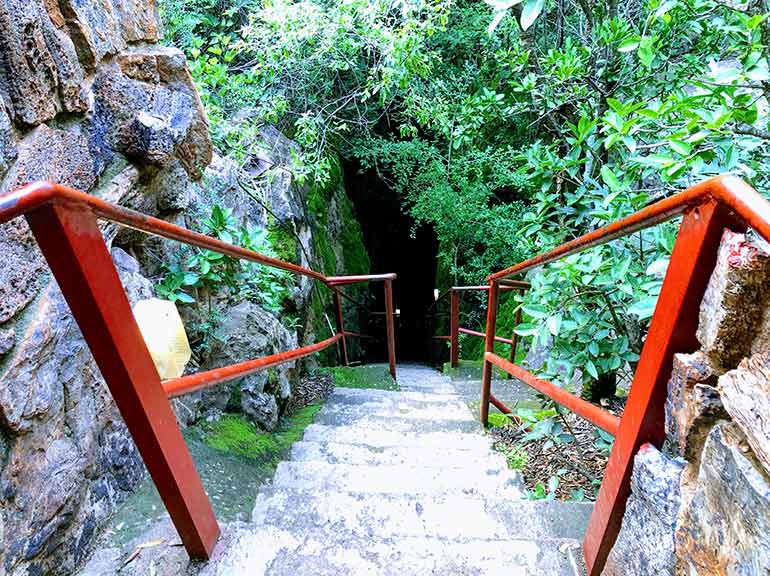
Protea 4×4 Training at the Reserve: Your Gateway to the African Bush
We booked our 4-wheel driving course with Jannie Rykaart from Protea 4×4 when we arrived in South Africa.
The amazing bonus of the Protea 4×4 course was that it was inside the Rhino and Lion Nature Reserve. Therefore, not only did we get to practice our 4×4 bush driving, but we did it amongst some of the amazing wildlife at the Reserve.
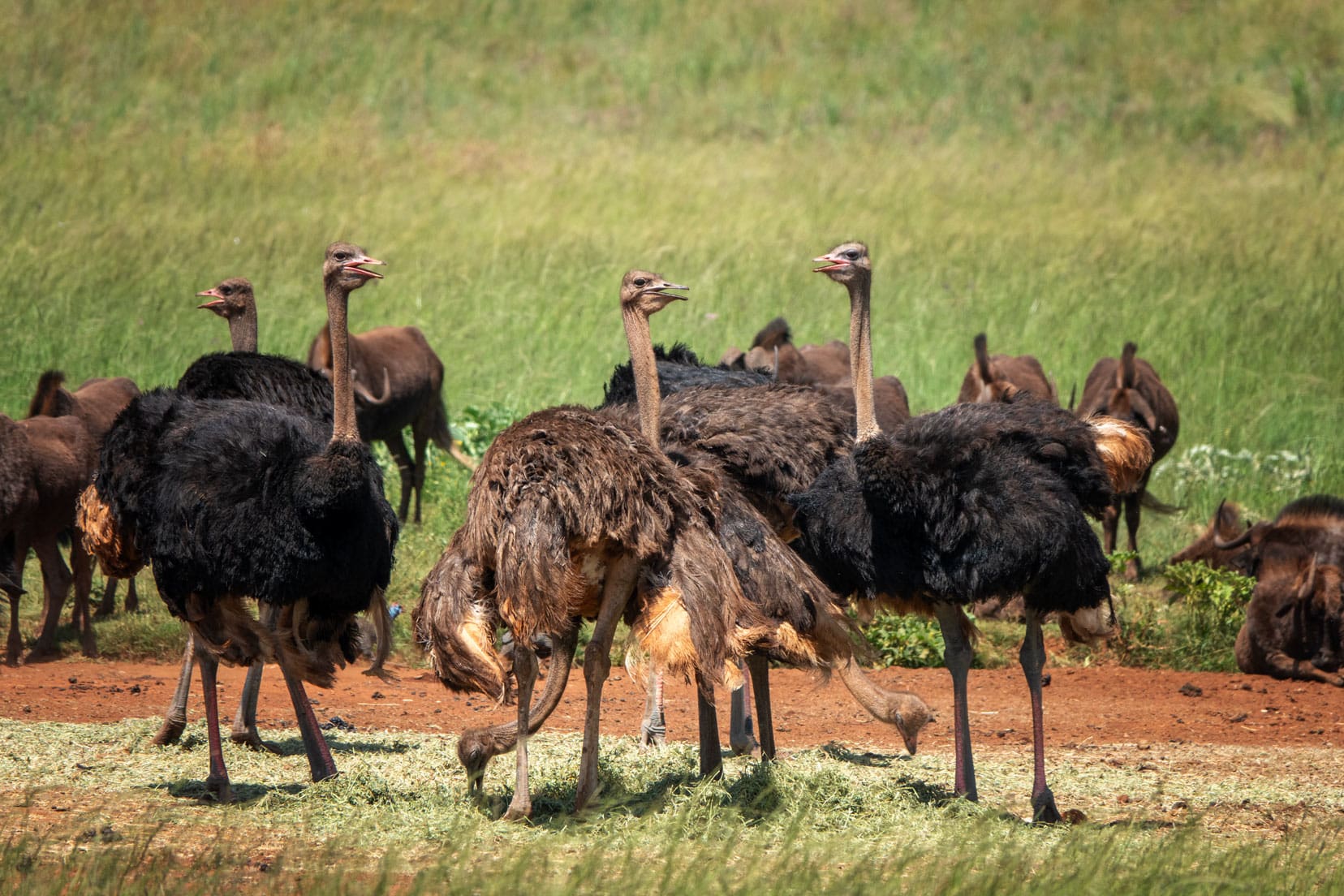
Ever thought about going off-road but didn’t know where to start? The Protea 4×4 Training at the reserve is more than just a fun day out; it’s essential learning if you’re considering an African safari adventure.
Why It’s Beneficial for A South African Trip:
- Unlock Remote Destinations: Mastering 4×4 driving skills allows you to explore places most tourists never see in South Africa.
- Navigate the African Bush: If you’re dreaming of a safari where you’re in control, this training is invaluable. You’ll learn how to handle rough terrains, river crossings, and even emergency situations.
- Safety First: Knowing how to operate a 4×4 in challenging conditions can be a lifesaver, literally. It’s not just about the drive; it’s about ensuring you and your loved ones are safe while adventuring.
Take the Wheel: If you’re planning an African safari or any off-road adventure, this 4×4 training is not just a ‘nice-to-have,’ it’s a ‘need-to-have.’
💡 Lifejourney4two Tip: Jannie can also give you lots of useful advice on the specific areas you will be driving to in South Africa and on routes and places to avoid.
If you’re interested in 4×4 training, you’ll find our 4×4 South Africa guide beneficial, especially if you’re planning to navigate the African bush on safari.
If you are lucky, while at Jannie’s place in the Park, you may catch a glimpse of ‘Bullet’, the rhino rescued as a baby.
She came really close to us while we were chatting about all things 4×4, and I must admit I left Lars to listen to Jannie while I went on a little ‘safari walk’ to take some photos.
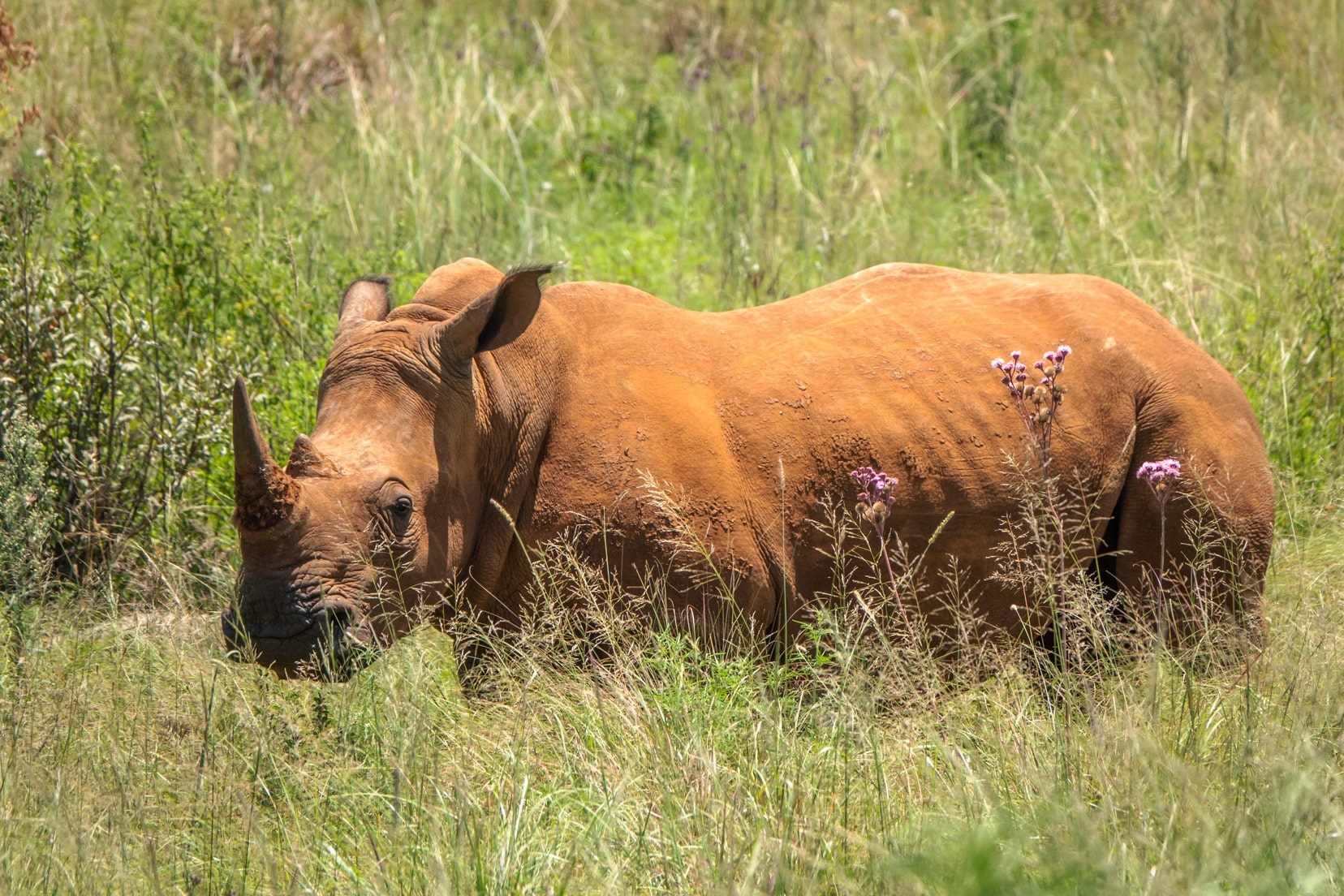
‘Bullet’ was found with a bullet lodged in her shoulder. Poachers had already killed her mother, and it was touch and go as to whether she would survive. Miraculously, the vets were able to save her.
Bothongo Rhino and Lion Nature Reserve Practical Info
Contact Details
Address: 520 Kromdraai Road, Krugersdorp, 1739
Contact: (011) 957 0106, (011) 957 0109
Email: [email protected]
Opening Hours
Open Tues-Fri 8 am-5 pm, Weekends 8 am-6 pm. Closed Mondays (except School holidays and Public Holidays)
Predator Feeding Times
1 pm Weds, Saturday, Sunday and Public Holidays
Rhino and Lion Park Self-Drive Prices 2025
Rhino and Lion Park entrance fee:
Adults: R240
Children: R150
Pensioner (60+): R180
Your entrance ticket gives you access to lots of activities. rhino and lion park entrance fee
💡Lifejourney4two Tip: Plan your day using the Field Guide you will be given with your entrance Ticket. This will have all the activity schedules, so read it on arrival and plan accordingly.

Best Time to Visit
- Morning Hours: Animals are most active
- Late Afternoon: Great for bird-watching
- Seasonal Tips: Summer for lush scenery, winter for easier animal spotting
Remember to pack
- Camera: You’ll want to capture every safari moment
- Binoculars: For a closer look at distant animals
- Snacks and Water: Keep hydrated and energized
Getting to the Rhino and Lion Park
If you are coming from Johannesburg, it should take you about an hour.
If you’re new to South Africa, you might find our post on driving in South Africa helpful.
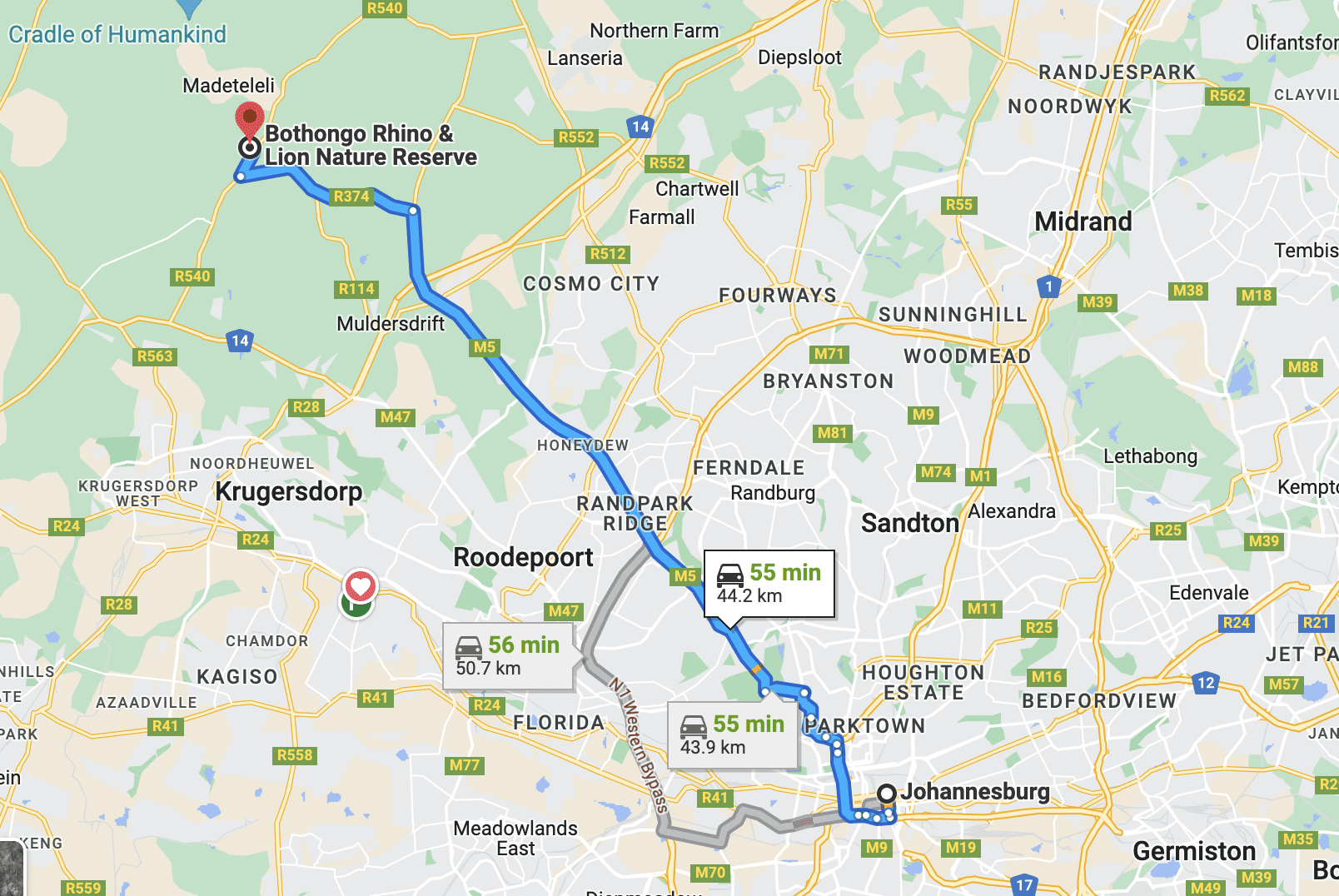
Rhino and Lion Park Accommodation
There are two types of accommodation options at the park: gorgeous stone cottages and log cabins —both options are self-catering.
If you are looking for accommodation just outside the park, then you might like to stay at Motubane Guest Farm, which has exceptional reviews, a private pool and mountain views.
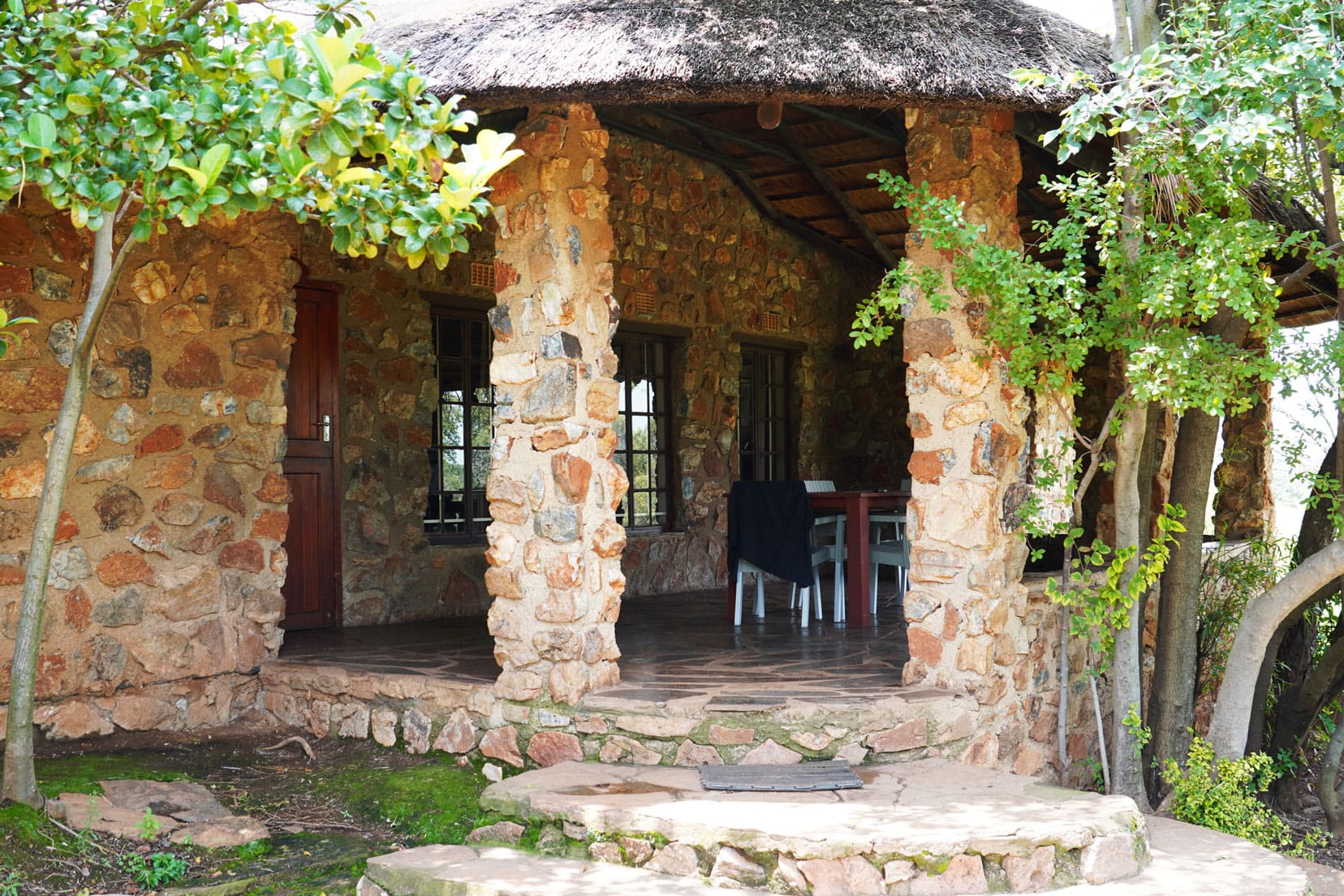
Restaurants and Cafes at the Reserve
There are several restaurants at the reserve:
- Boma Restaurant – near the Visitors Day Centre
- Thatch Cafe – by the bike park and the Pidipidi Play Park
- Neck and Deck Restaurant – near the entrance
We ate at the Neck and Deck Restaurant, which is right beside the free parking area before the main gate to the Rhino and Lion Nature Reserve.

Neck and Deck Restaurant
We ate at the Neck and Deck Restaurant, which is right beside the free parking area before the main gate to the Rhino and Lion Nature Reserve.
We don’t normally post about what we have eaten, but the Neck and Deck burger we ate has to be one of the best we’ve ever tasted — we highly recommend it. It cost about R130 (just under 7 USD) and was epic!
You can also feed the resident giraffe here.
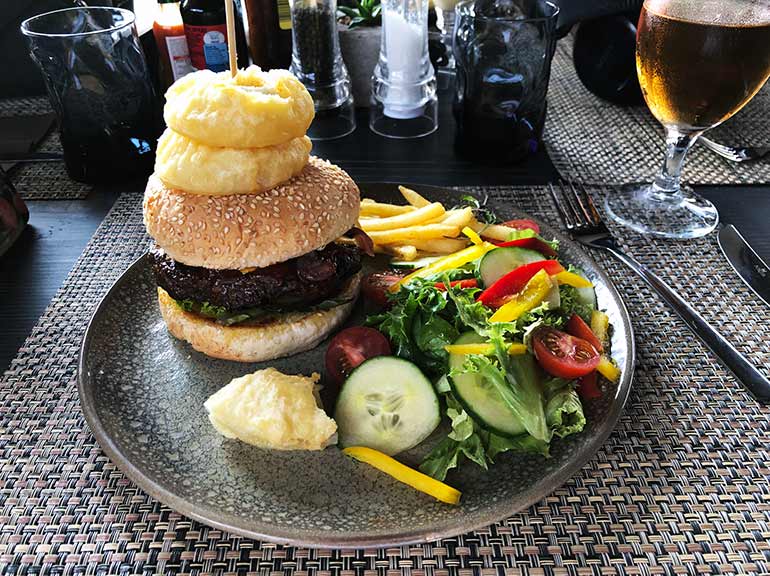
Bothongo Rhino & Lion Nature Reserve … That’s a Wrap
So there you have it—a comprehensive guide to spending a day at the Bothongo Rhino & Lion Nature Reserve.
It’s a stone’s throw from Johannesburg, and you don’t need to trek halfway across the continent. Plus, it’s a day out that’s as educational as it is interesting.
- Why Visit: The park provides a close-to-nature experience without the long drives often associated with safaris. Plus, it’s a fantastic educational outing for kids and adults alike.
- What to Do: Whether you’re a nature lover keen on bird-watching or an adrenaline junkie interested in 4×4 training, there’s something for everyone. And don’t forget, guided tours offer a deeper understanding of the Cradle of Humankind area.
- Plan Ahead: Make sure to check out the lion and rhino park feeding times and any special events to make the most of your visit.
If you enjoyed this post, Pin and Save it for later
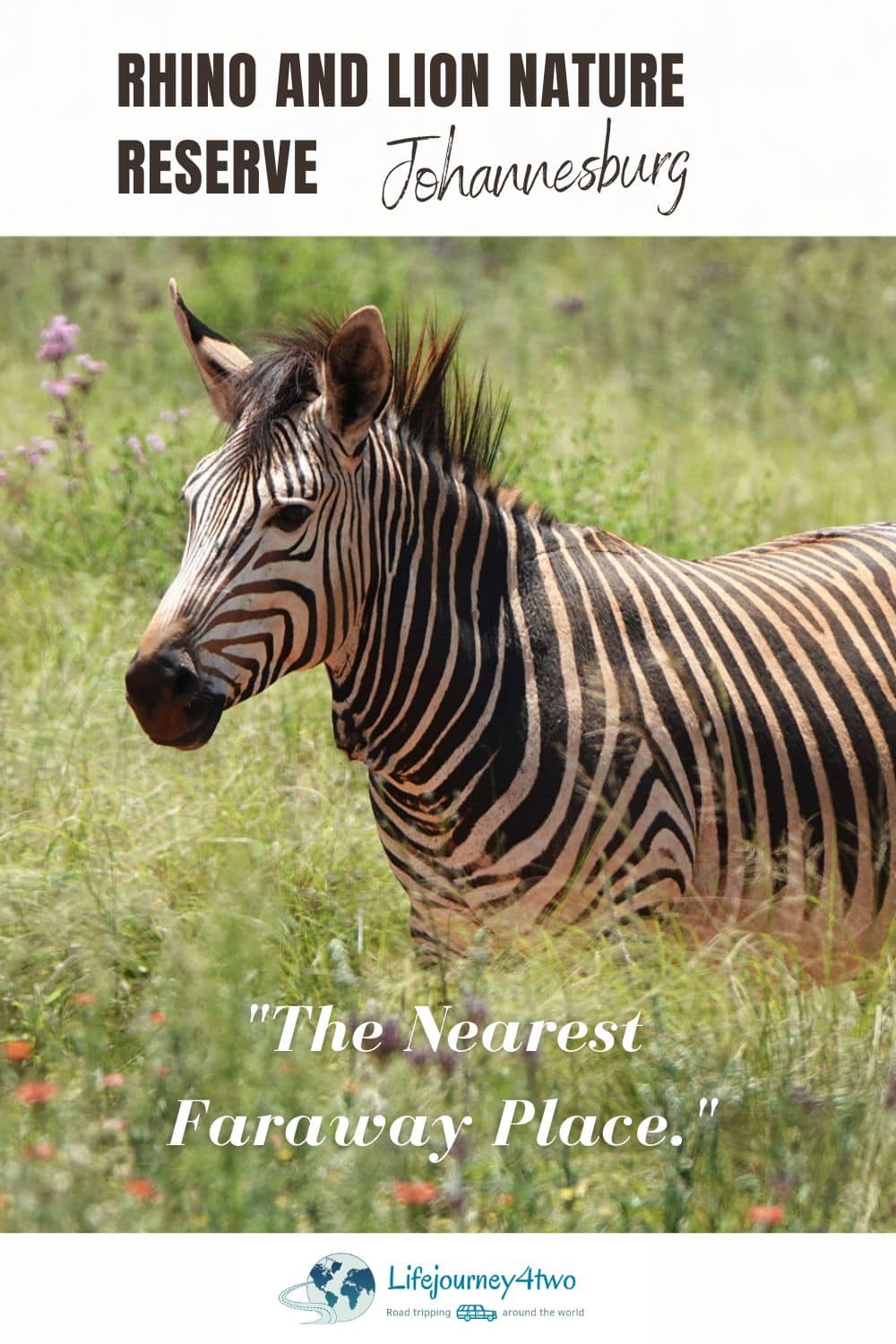
You May Also Be Interested in Reading:
- Guide to driving the Sani Pass, another thrilling adventure in South Africa.
- An Australian Take on Life in the South African Bush
- Monkeyland Plettenberg Bay: Furry Friends Afoot
Planning Your Travels?
These are the travel resources we recommend and use when planning our trips.
- 🚘 Car Hire: We use DiscoverCars.com
- Motorhome/Campervan Rental: We highly recommend the Motorhome Republic
- 🪪 Order your International Driver’s Licence online here
- ✈️ Flights: Find flights on Skyscanner
- 🛏 Book Accommodation: We use Booking.com to find accommodation that suits our budget
- 🐶 Pet Sitting/Pet Sitters: Check Out TrustedHousesitters here (Use our Discount code: LIFEJOURNEY25 for 25% off. )
- Activities and Experiences: Get Your Guide and Viator
- Travel Insurance: Safetywing or World Nomads
- 🥾 Travel Gear and Accessories: Check out our top picks here — Lifejourney4two page on Amazon
For a more thorough list, visit our Travel Resources page here.

